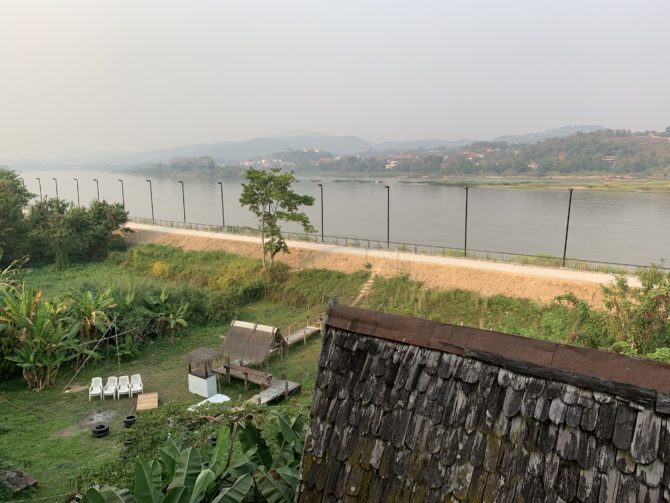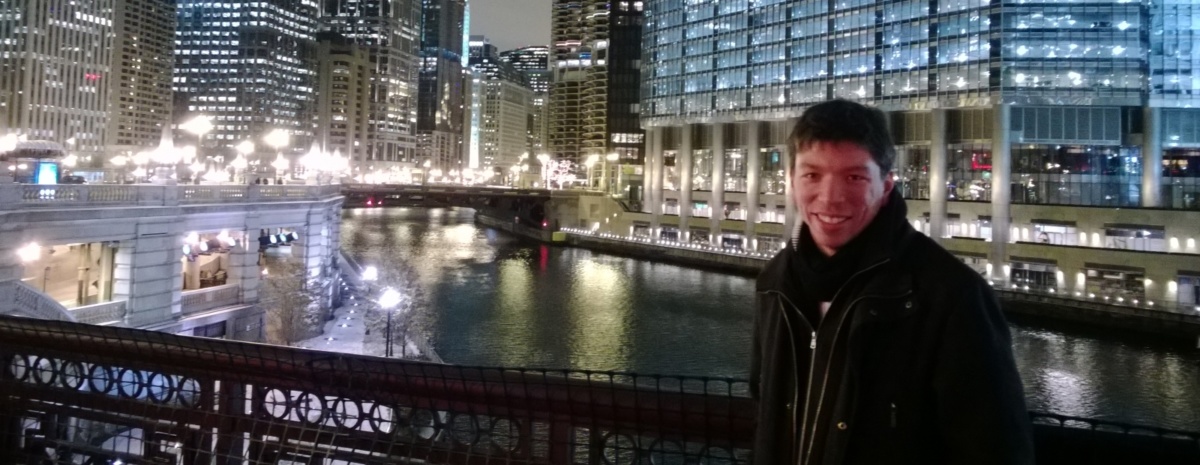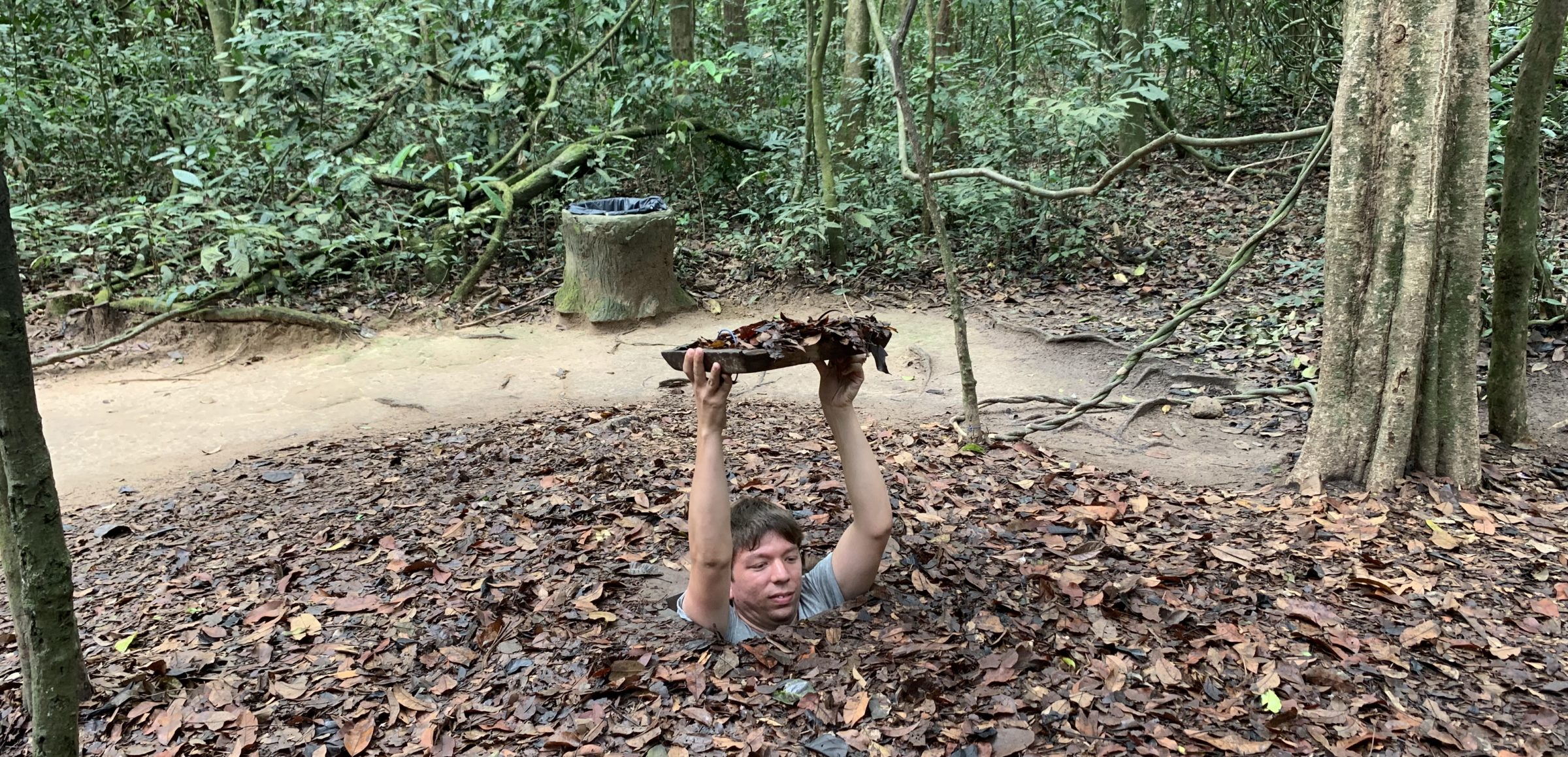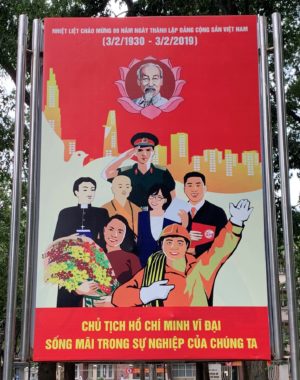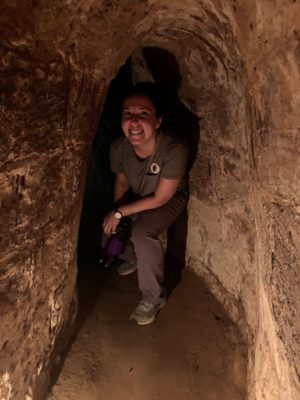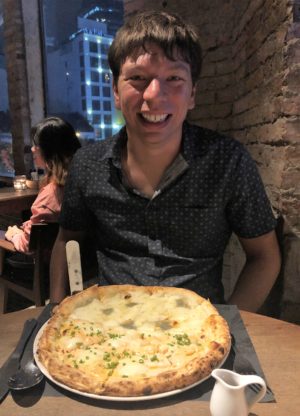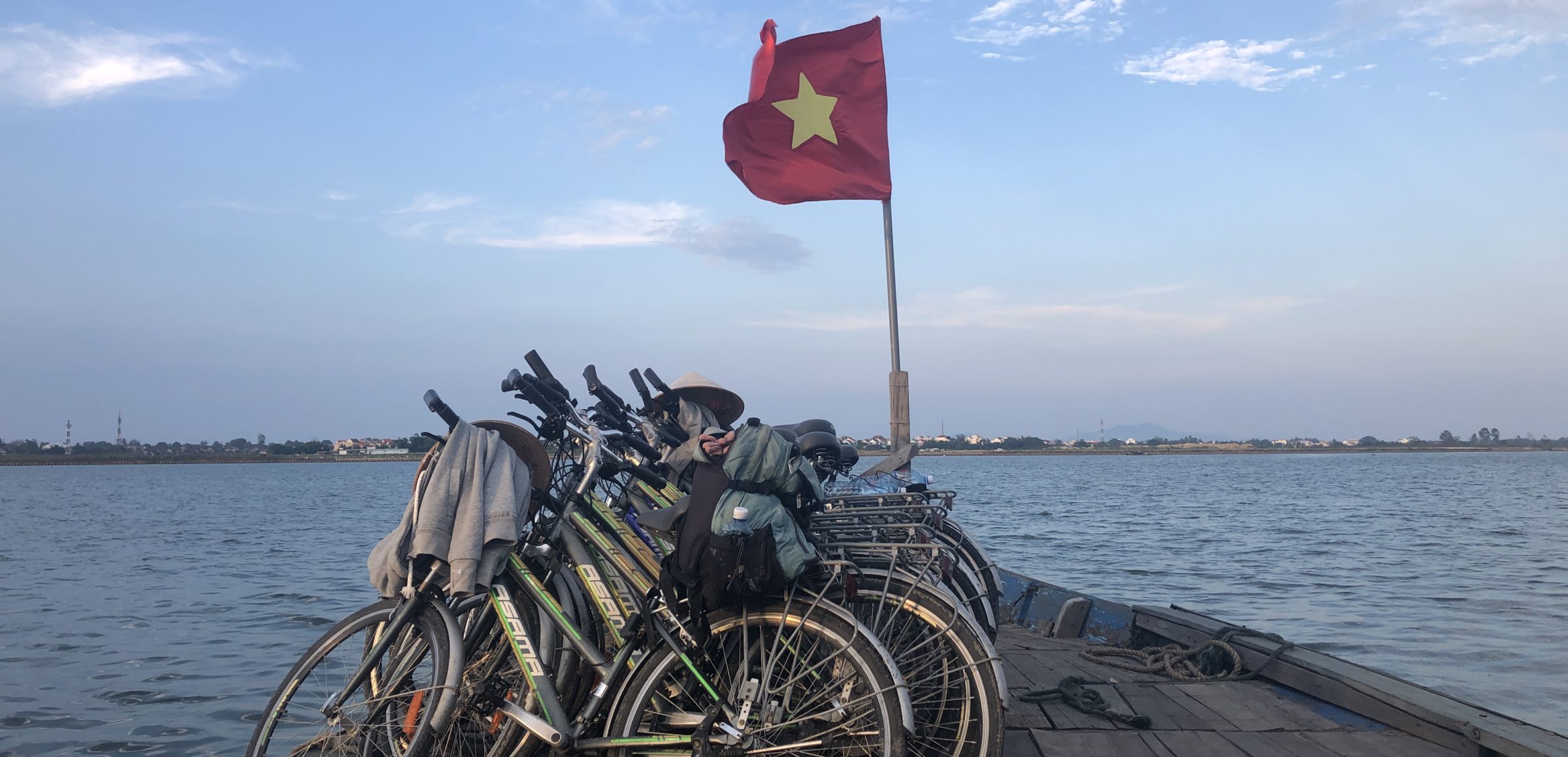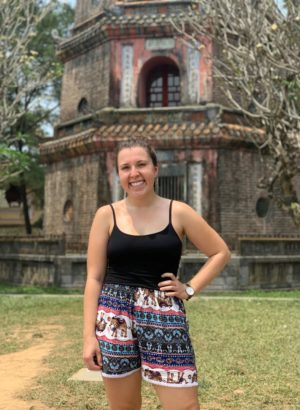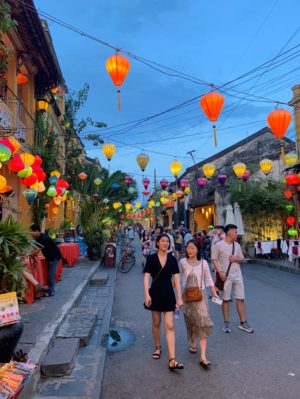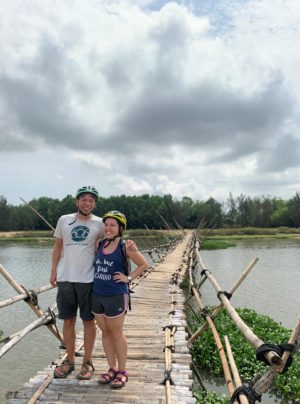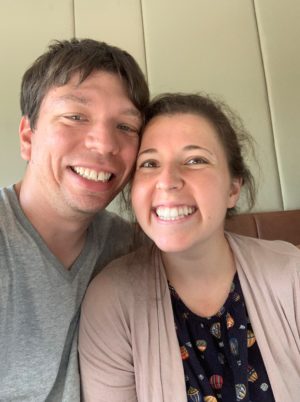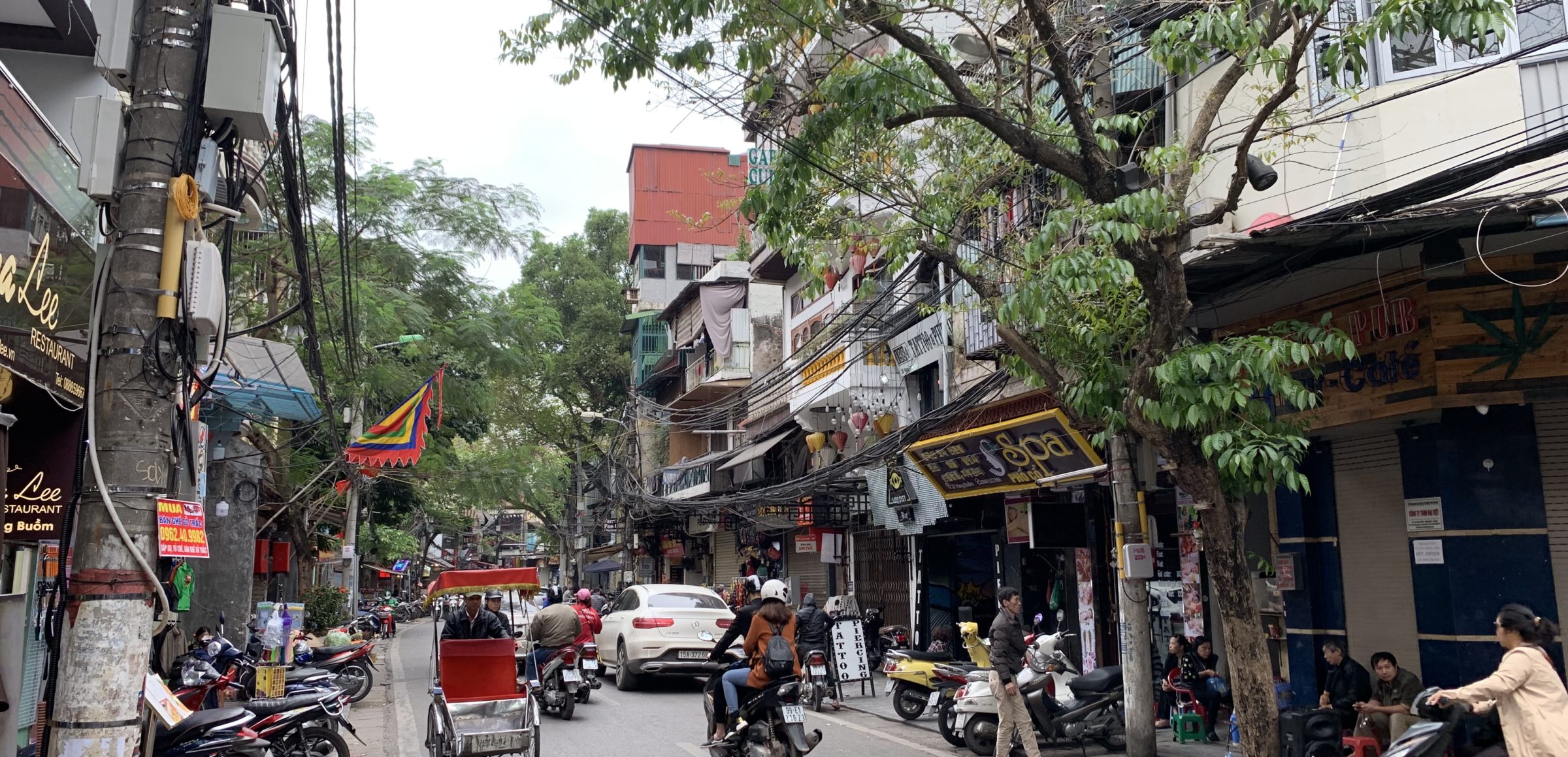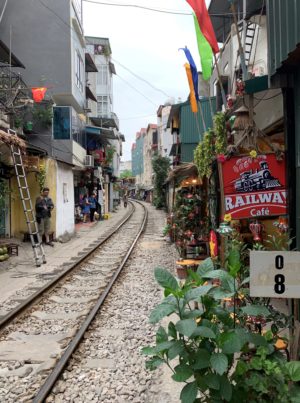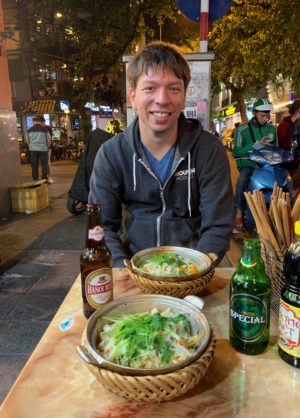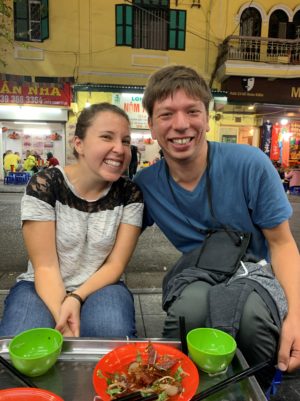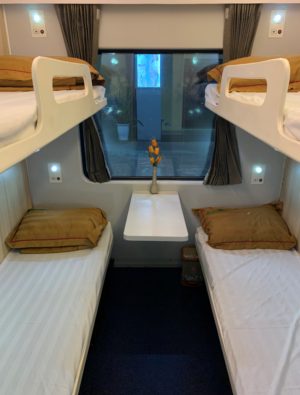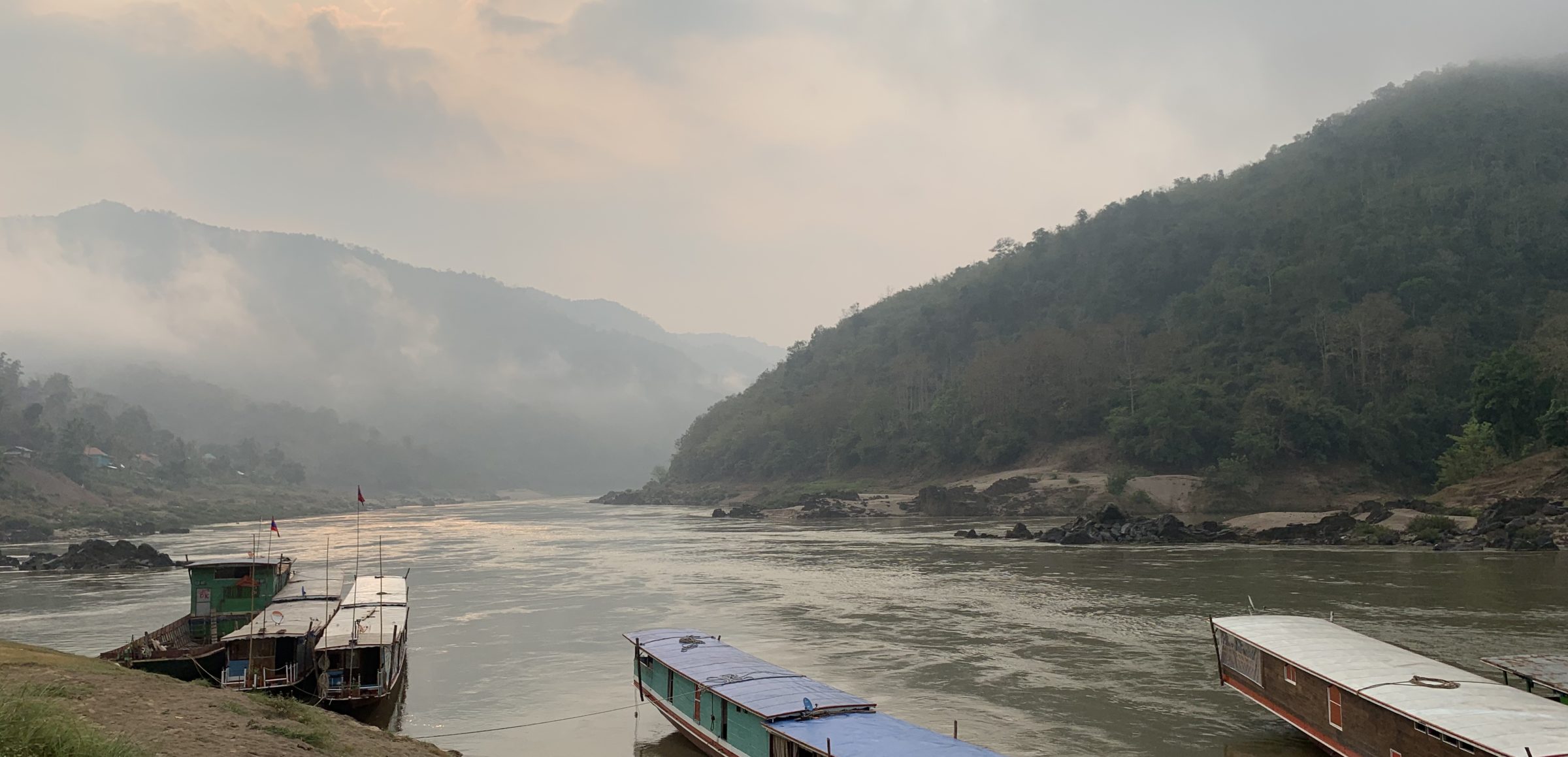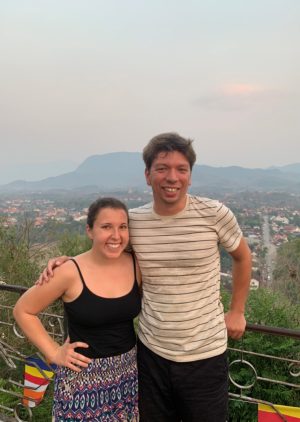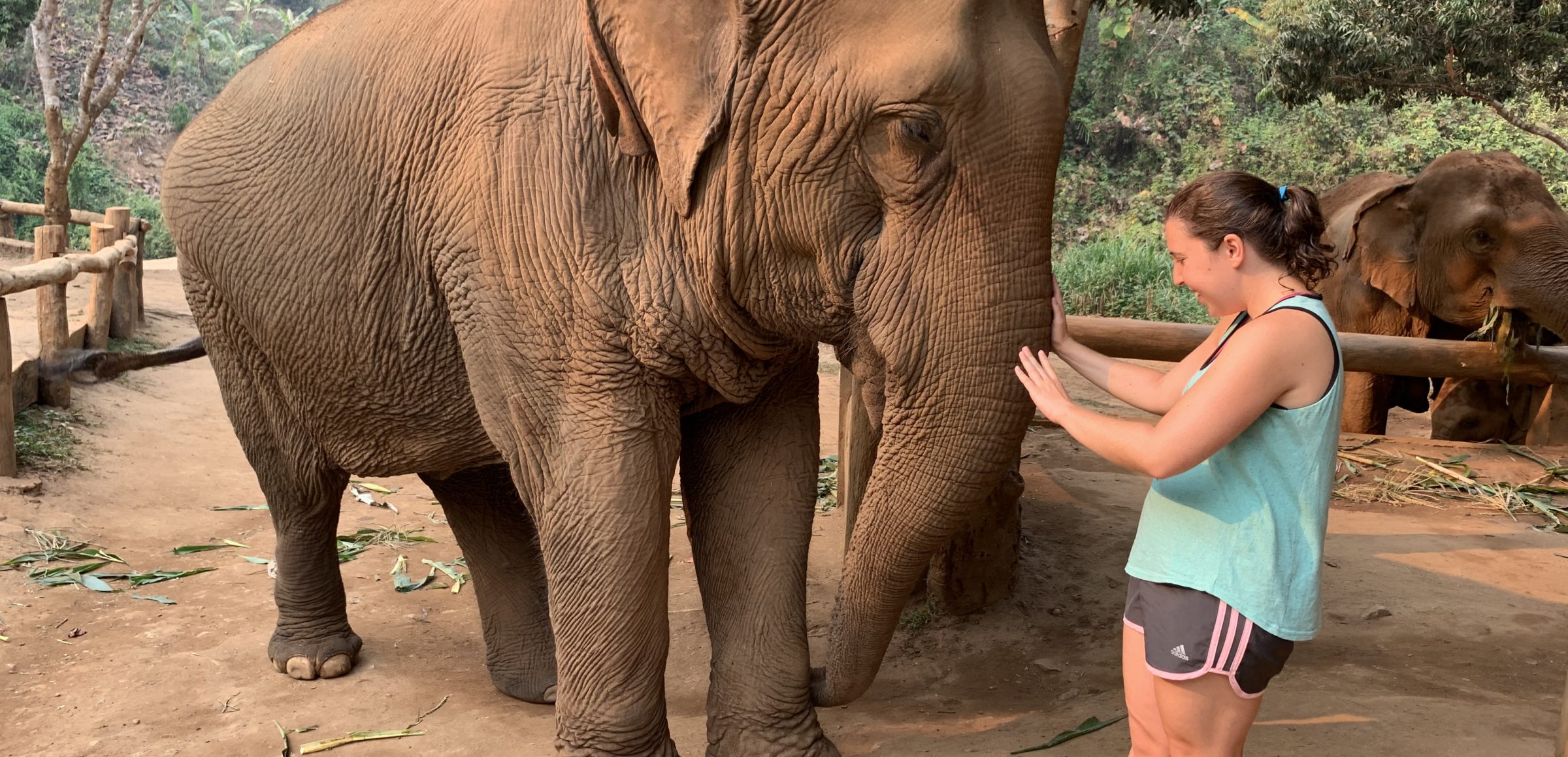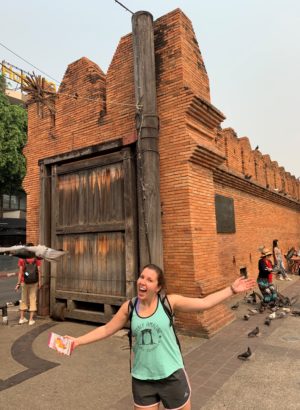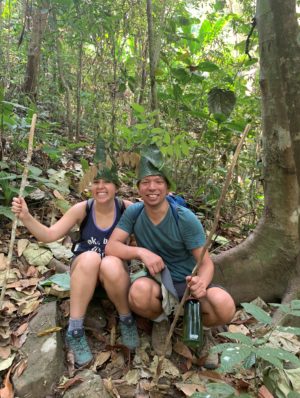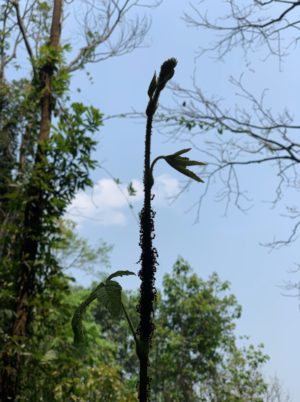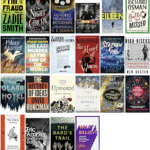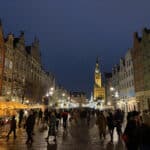So, wait, is it Ho Chi Minh City or Saigon? The answer, a little unsatisfyingly, is both. Obviously this is a political story, with Saigon being the capital of South Vietnam until its fall in 1975 and the reunification of the country. At that point Saigon was merged with the surrounding area and became Ho Chi Minh City for official purposes, but the name Saigon is far more commonly used around the actual city itself, including the railway station and all of the businesses. It’s also very unwieldy to say ‘Ho Chi Minh City’ out loud, plus there is a convention that the central part is still Saigon. So take your pick.
Whatever you call it, I think it’s undeniably less charming than Hanoi. The streets are wider, making the traffic that much more intense if you want to cross a road, and it’s very much the country’s commercial centre rather than the quieter, more government-focused capital up north. I will give it to them that bánh mì – their flagship street food – is considerably more appetising than phở. And that our hostel provided one free beer every night during happy hour – a good way to ready ourselves before heading out into the jungle of motorbikes for dinner.
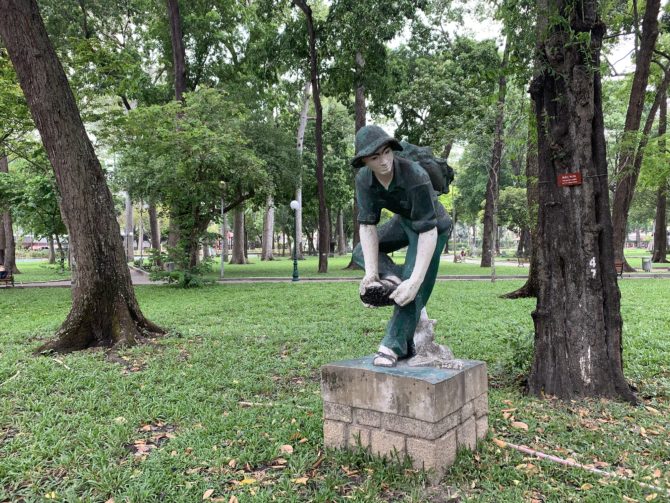
The only bona fide tourist attraction we visited in the city itself was the Independence Palace, former home to the President of South Vietnam. The explanatory text around the building was on the better side of the museums we have seen here, and relatively neutral and descriptive in its tone. Touring the rooms downstairs did feel a bit like scouting a potential conference venue, and I half-expected someone to appear to compare different seating arrangements. In the basement lies the presidential bunker, replete with lots of war maps on the walls, ancient communication technology and dark corridors from one of the N64 Goldeneye levels.
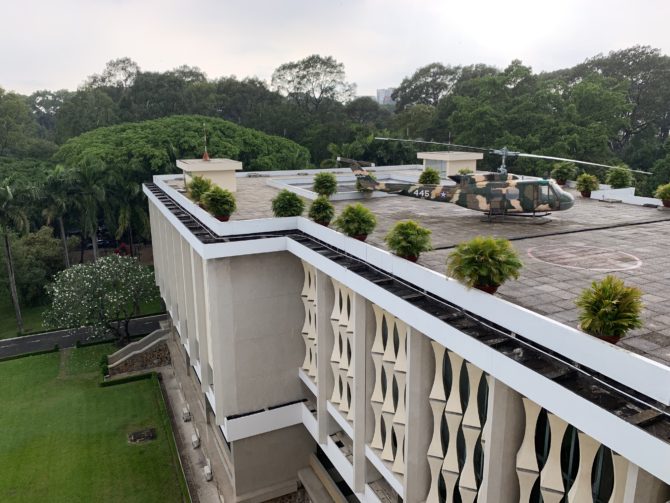
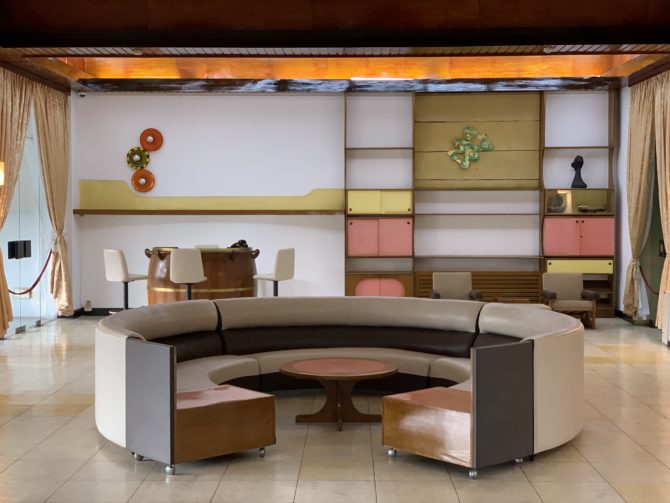
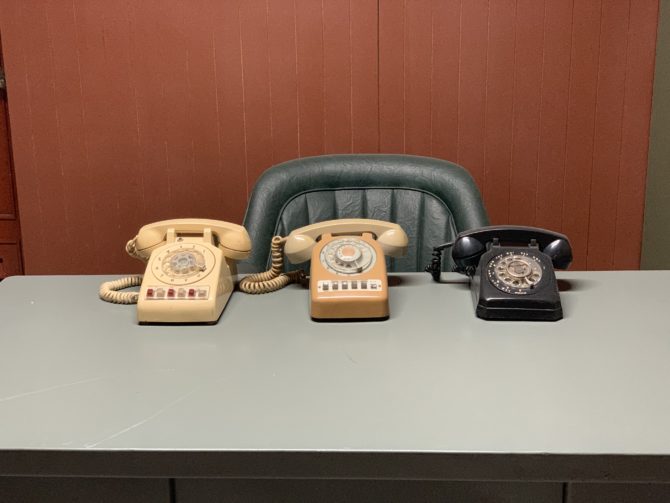
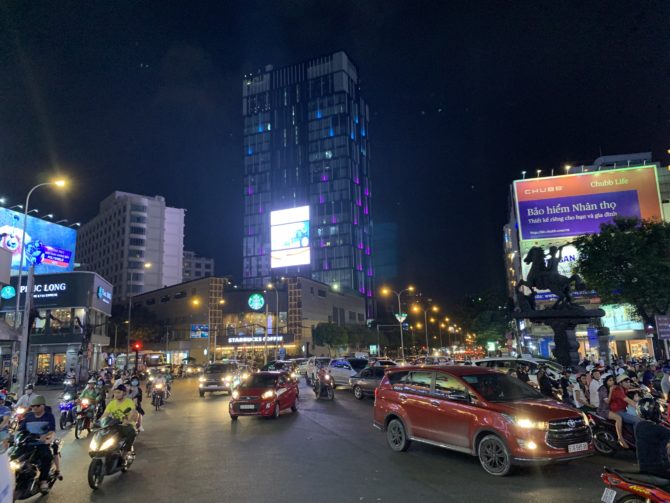
The number one thing to do here is to visit the Củ Chi tunnels, a giant underground network which lie a couple of hours’ drive outside the city and were a significant operational base for the Viet Cong during the Vietnam War. I was a little nervous about seeing these, as I had read that they have become touristy to the point of being distasteful to the memory of a war in which millions of people died not so long ago. There are two sites available for visits: Ben Dinh, which is closer, and Ben Duoc. To ease my fears about the trip we booked a small tour group to Ben Duoc on the basis that it is “less touristy”. I was a bit sceptical that this could really be true given that the advice to choose Ben Duoc is repeated all over the Internet, but in actual fact the blogs had it right this time and the site is still relatively quiet, uncrowded and respectful.
Our tour guide was a retired teacher who had been a reserve solider in the South Vietnamese army and was in love with English idioms, working them relentlessly into conversation (“sucker for a pretty face”, “it takes two to tango”, “really hard done by”) before repeating them quietly to himself under his breath for practice. He was cheerfully dismissive of the North Vietnamese “exaggerations” around the exhibit and wistful about the multi-party system in Vietnam which might have been. It was good to get a different perspective on the war from someone local. For balance, we were also shown a grainy propaganda film about the “crazy bunch of devils” (i.e. the Americans) who bombed the country relentlessly before being taken to the tunnels themselves.
Before visiting, I thought it was the height of absurdity that some of the tunnels have been widened for Western tourists. Having been there, I still think it’s absurd but I have accepted the fact that I would probably still be stuck in the original tunnels if they had not been. We bent over and near-crawled through several short sections of tunnels – stopping to see mannequin figures stand in for Viet Cong fighters in underground rooms – and my knees hurt even after these very brief explorations. It’s crazy to imagine what this network must have been like, before any electric lighting or paths cleared through the jungle, in the middle of a brutal guerrilla war.
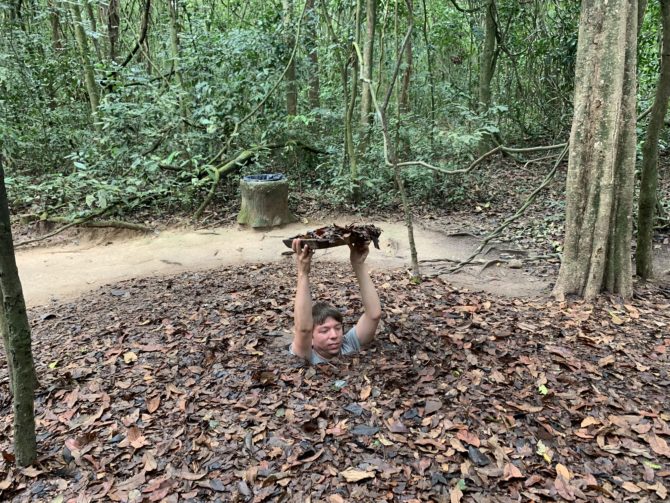

I was less keen on the gleeful presentation of various gruesome booby traps. They are morbidly fascinating to see, of course, but it brought home the arbitrary unfairness of time and place that I was here on a tour group rather than a military draft. And I was very grateful that our guide completely vetoed a trip to the shooting range on the grounds that it was a rip-off, because I really don’t have any desire to fire a gun, even for fun.
Fun side-note: we smelled a little of baby food during this outing, after accidentally buying our mosquito spray from a children’s shop and ending up with weird-smelling protection which is apparently “ideal for the little ones”. It did seem to ward off the mosquitoes, though.
Tomorrow morning we will catch our bus out of Vietnam and into Cambodia for the last new country of our travels. Overall, Vietnam has surpassed my expectations and I really enjoyed the experience of travelling down the length of the country, although we have realised that there are plenty of other stops we could have chosen and – one day – we might repeat the route with a whole new itinerary. Ho Chi Minh City will likely not be included unless they manage to sort out their roads, though 😉
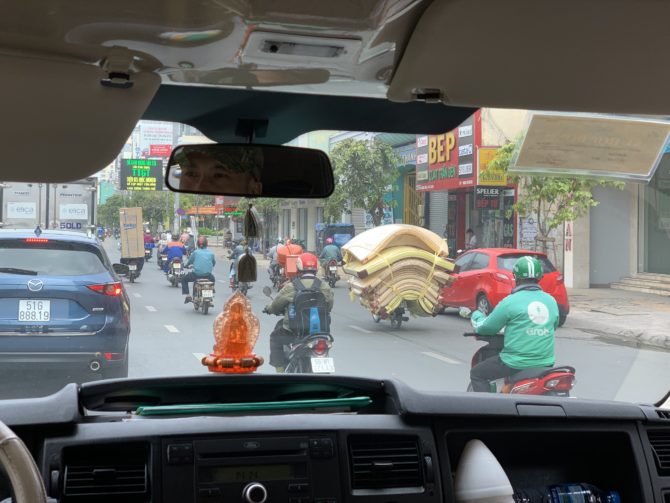
Last week’s episode concluded with the overnight train to Hue, so now the story continues from our arrival at the railway station. If it were up to me I would prefer to rhyme Huế with the word blue to match the city’s quiet, gentle vibe… but it’s not up to me and Huế is actually pronounced as ‘hway’, which at least rhymes with the word yay.
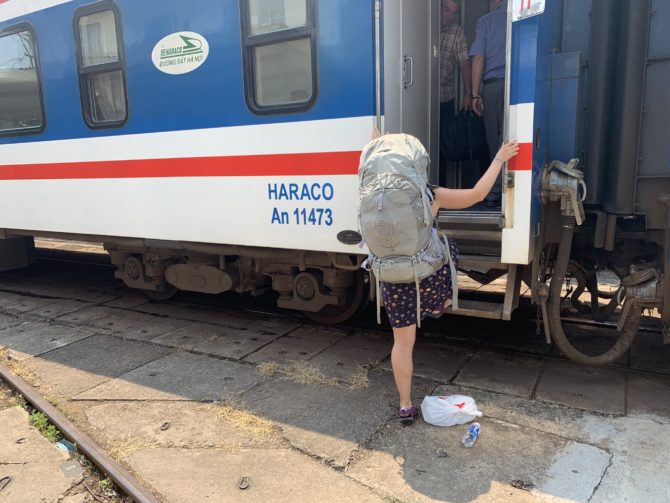
I really liked it here. It had a certain feeling which hasn’t quite been replicated anywhere else on our travels, no doubt due to the fact that we were staying within the small central nineteenth-century citadel without any tall buildings and – at least according to our AirBnb hosts – where hotels are not allowed. A large chunk of the citadel is taken up by the Imperial City. This is where Vietnam’s emperors ruled the country until 1945 when power was handed over to Ho Chi Minh’s new republican government and the capital was moved from Huế to Hanoi. It was rather heartening to learn that after his abdication, the last emperor lived until 1997 and some of his descendants remain in the city to this day. You rarely see a revolution which doesn’t end in a violent purge.
Anyway, we walked over the bridge from the station and into the citadel, catching a glimpse across the river of the more modern, built-up area of Huế. Our home backed onto a large grassy square with a brick structure designed (allegedly) for royals to be able to pray for rain. It is currently well-used by lots of local children, the older ones playing football while the youngest pair opting for the classic ‘fight each other with sticks’ game instead. Vietnam as a whole has felt like a very young country with lots of children around but we had particularly nice interactions with children in Huế, from the kids who waved to us through the open door of their school (still studying, long after sunset, at 8.30pm) to the young boy who walked up to me in a bookshop and asked if it was OK for us to talk for a bit. And in general the streets of Huế just felt very relaxed, with many lakes dotted around everywhere in addition to the Perfume River.

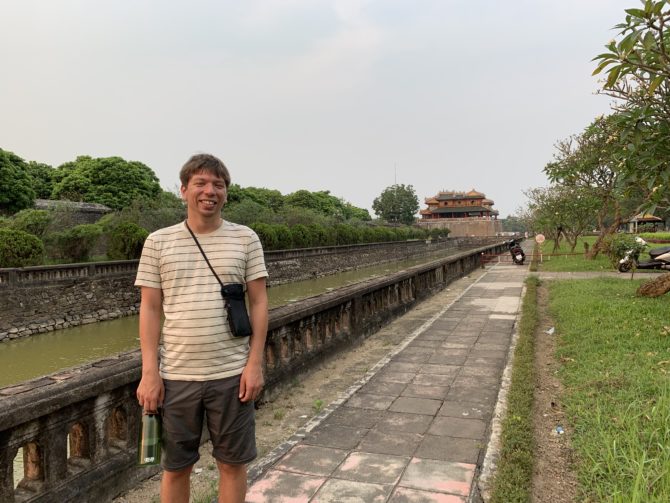
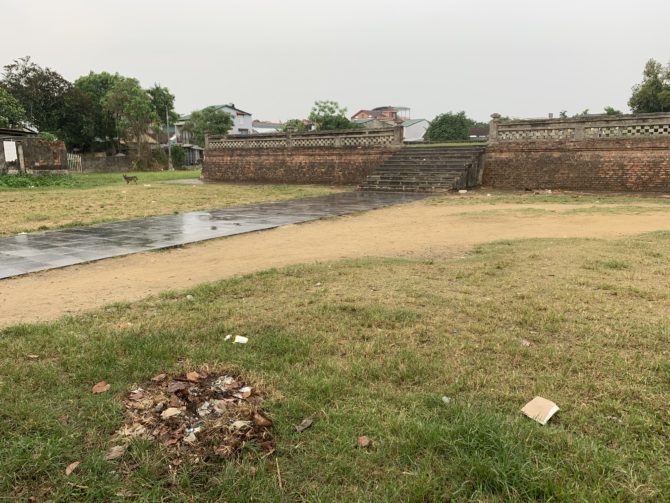
That said, there is not so much to do that you need to spend very much time here. We could have gone to the Royal Tombs which are at the top of many tourist lists and I’m sure are interesting, but we satisfied ourselves with a half-hour walk to the Chùa Thiên Mụ (Pagoda of the Celestial Lady) instead. It was fine. I mean, it’s a perfectly decent pagoda, but we were very hot and sweaty after the walk there and the best part was getting into an air-conditioned Grab to go back home. We didn’t pass anyone else walking, obviously, although many passing drivers looked at us strangely.
The Imperial City was a more successful visit which we left to the last day. I might have appreciated a more general outline of Vietnam’s history – this is perhaps what you pay a tour guide for – but there were plenty of interesting snippets amidst the remains of the buildings and the grounds. (Huế was heavily damaged during the Vietnam War, particularly during the Battle of Huế in 1968.) Afterwards, we took a brief look at a display of American planes and tanks nearby. This was the underwhelming climax to a wild goose chase across Google Maps where I tried to find the old airport listed as #9 in one of those ‘top things to do’ articles which I’m refusing to link to here. If you’ve found this blog trying to do the same thing, then let me save you some time: it doesn’t exist. And the clue is that the article is illustrated with a photo of the international airport which is very much in use.
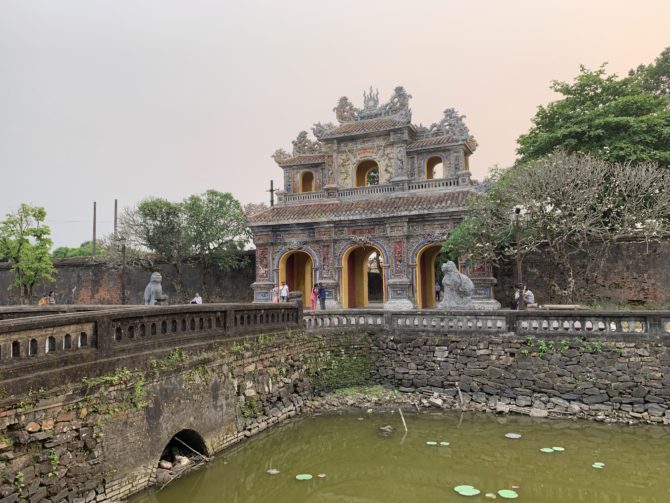
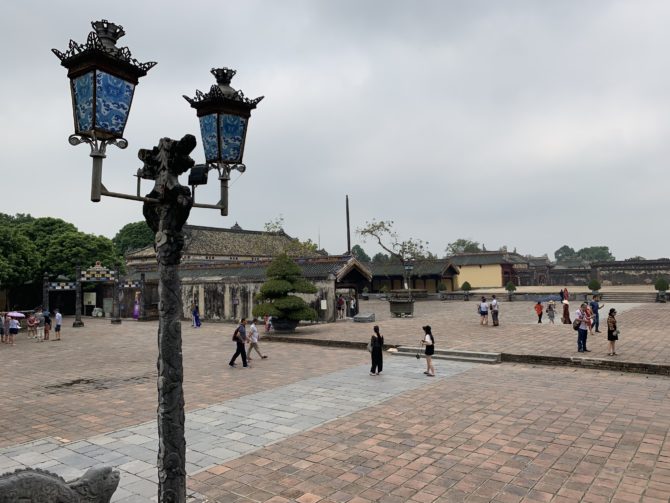
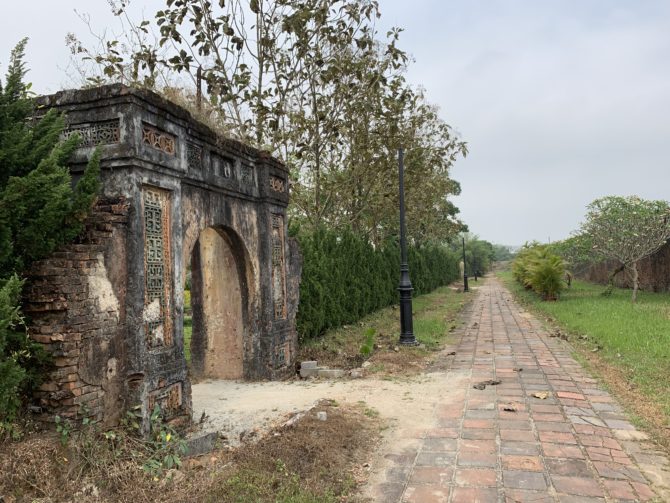
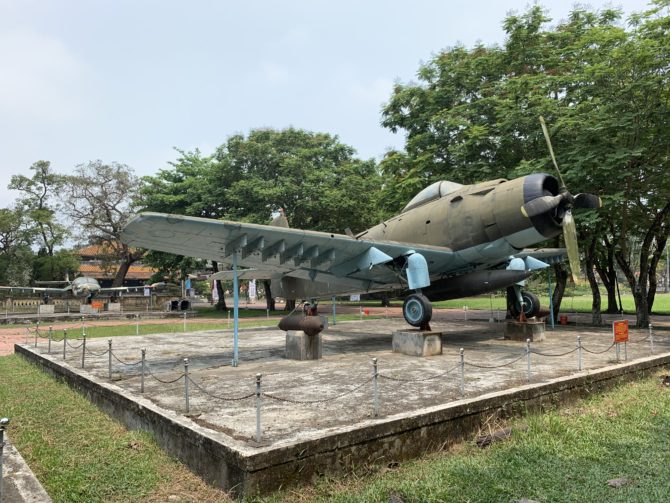
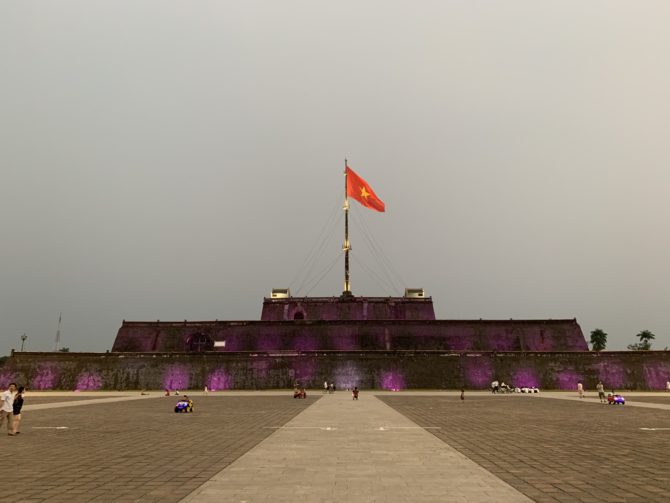
The legitimately great (and 100% real) discovery of Huế was salt coffee, which continues the trend of unusual Vietnamese coffee creations started by the egg coffee in Hanoi. The name is slightly clickbaity, since the salt is more than offset by the sweet caramel taste, but it was delicious all the same. Food-wise, Huế was out of the zone where all of the menus can be expected to exist in English, but we did still manage to try some of the dumplings recommended by our hosts.
On Thursday evening we caught the two and a half hour train from Huế to Da Nang, the nearest station to the popular tourist destination of Hoi An which is a further 45-minute drive away. The train was not awful – and ran exactly on schedule, like all of the other trains in Vietnam have – but was somewhat grottier than the other trains we’ve taken in Asia and at one point a rodent scurried over Randi’s foot. We spent the rest of the ride resting with our legs away from the floor, including during the brief period when all the lights went off and it felt that an Agatha Christie murder mystery might be afoot, until the sweetly-phrased announcement of “ladies and gentlemen, the train has taken you to Da Nang”.
In general, though, I must say that the chaotic image of Vietnam’s railways which I had picked up online beforehand couldn’t be further from the truth. Everything has been straightforward and well-organised and it should be noted that the online ticketing system here actually works, unlike in Thailand where ‘real’ online booking is not actually available and the gap is filled by efficient third-parties who take your order, buy the tickets in person on your behalf and then set up offices near every train station for ticket collection. So please don’t let one mouse (or rat, we’re not sure) put you off the trains in Vietnam. I also suspect the sleeper berths on that train would have been nicer.
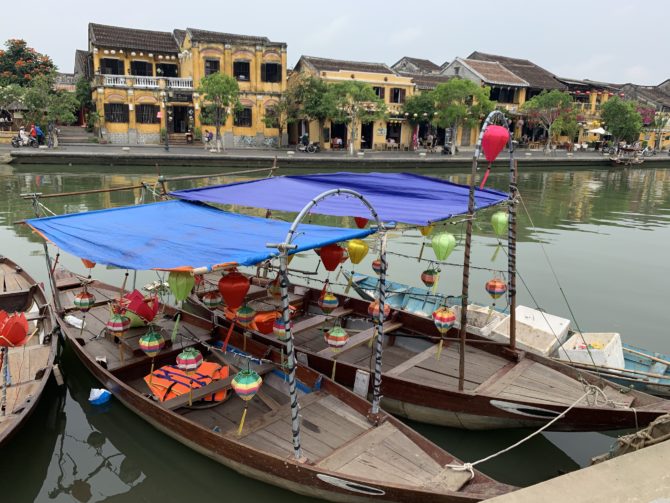
We had heard many good things about Hội An, and I suspect most people would prefer it to Huế. The historic Old Town by the Thu Bồn River is exceptionally pretty, especially in the evening when everything is lit up by lanterns. It also has the big advantage of being a couple of degrees cooler, with periodic rainfall which was incredibly welcome and refreshing.
It also has a much more touristy vibe, which I guess suited me just fine when it was dinnertime and we could take a break from Vietnamese food in favour of cheese-filled burgers or lamb kormas (both excellent).
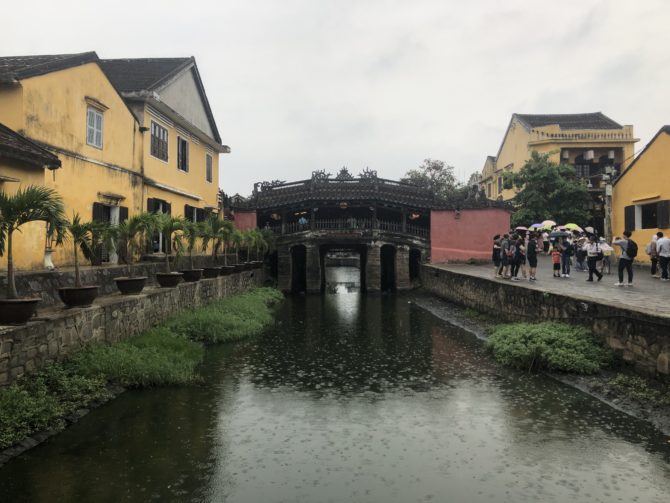
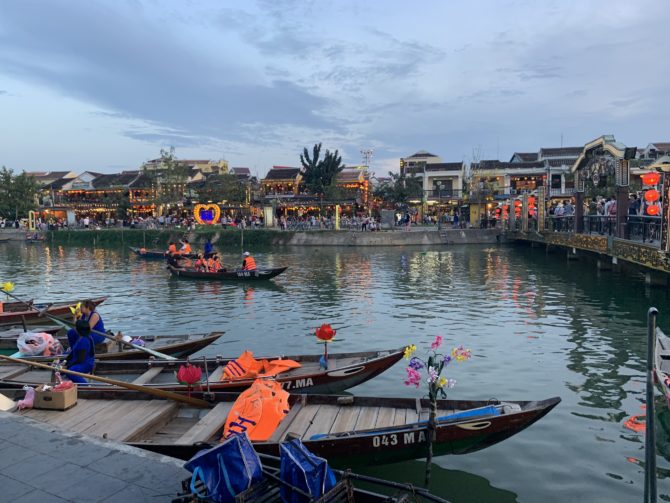
We didn’t spend a ton of time in the town itself, though, opting instead to spend our full day in Hội An on a Heaven & Earth cycling tour. After our last bike ride Randi had to convince me that this was a good idea, but this time we were part of a group being led through the countryside by some wonderful guides who were also a bunch of prank-loving jokesters. We cycled over 23km of very flat (though not always very smooth) paths, moving in and out of tiny villages, and really loved the experience. One of my favourite parts of seeing this ‘real Vietnam’ was passing through a field with a loudspeaker playing the local news. We also saw some local crafts including mat weaving, noodle making and boat construction, while at lunch I upset the American couple by slating Thomas Jefferson. (Well, to be fair, I don’t think I actually upset them. They were a nice pair of elderly anti-war types from Oregon. But they had not yet come over to team Hamilton.)
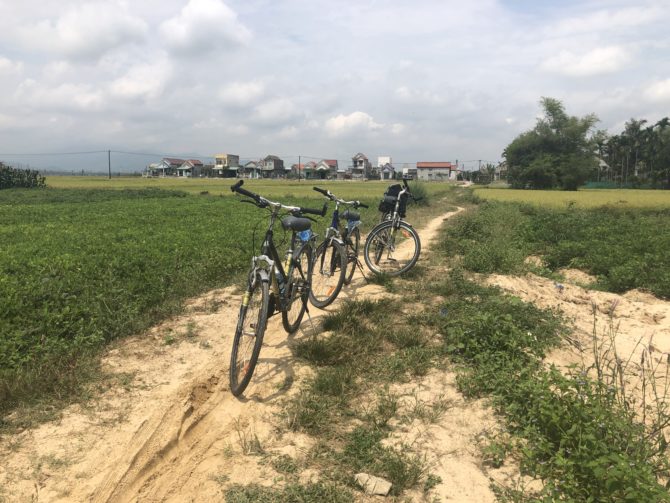
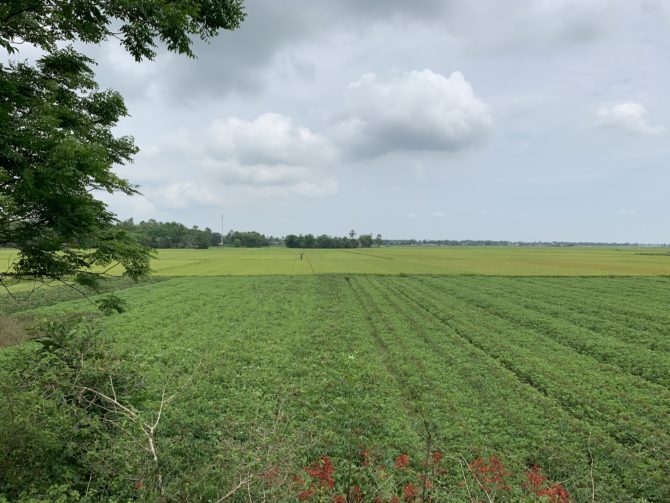
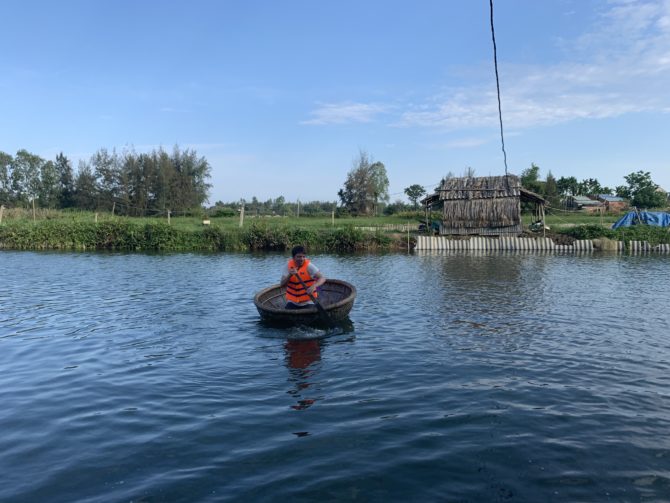
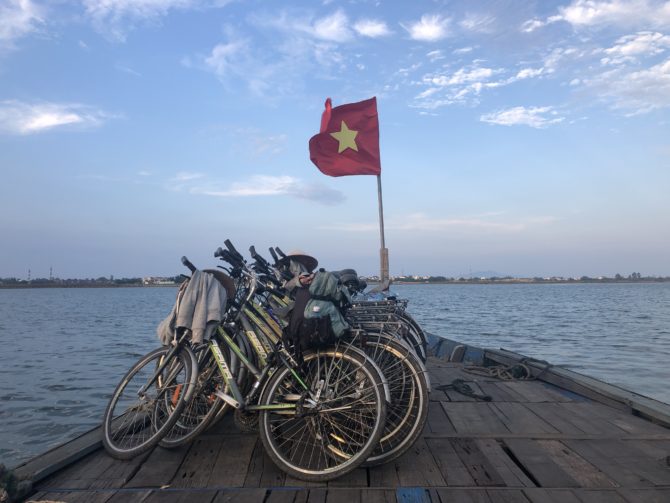
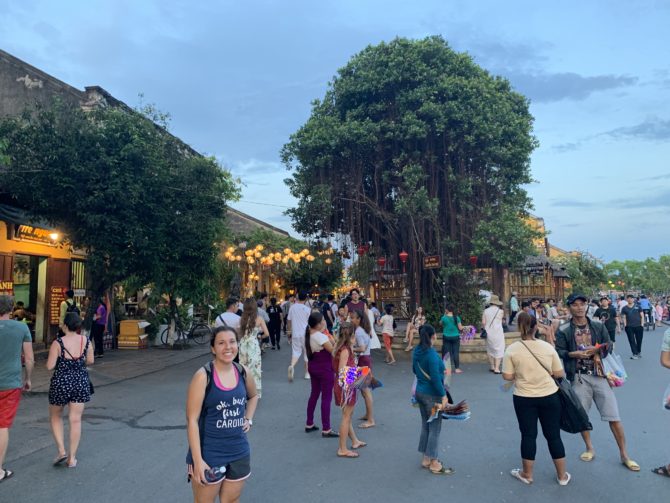
The trains in Vietnam are numbered, with SE1-4 being the newest and nicest. Our first sleeper in Vietnam had been a four-berth on the SE1 but our overnight to Ho Chi Minh City was booked on the older SE7, the same train we had taken between Huế and Hội An with the rodent. That honestly wasn’t the main reason we decided to switch trains at the last minute… we mostly realised that we preferred the timings of the SE1, and the nicer train was a bonus. But after confirming that we could get a 90% refund on our original ticket, we then discovered that the only beds left on the SE1 was the special two-berth VIP room. So, y’know, we just had to… 😉

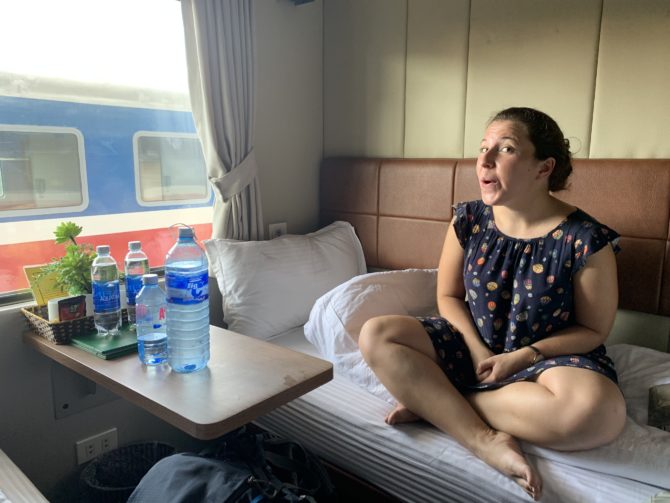
Splurging on the VIP option turned out to be an incredibly smart decision and turned our longest (16-hour!) train journey of the trip into yet another highlight of Vietnam. Although we had no problems with our fellow passengers on the four-bed sleeper, being able to lock our door, control the lights and spread out our stuff on our own schedule felt extra secure and very luxurious. At least two separate people walked past our room and said “wow!”. The beds were especially comfortable for a sleeper train and we were also treated to a free dinner, albeit one heavy on the meat so Randi had to fallback to her back-up dinner plans. Overall the journey time flew by and we even managed to get a bit of blogging done. I am full of admiration for Vietnam’s railways and a little sad that we have to downgrade back to buses for the rest of our route through Southeast Asia.
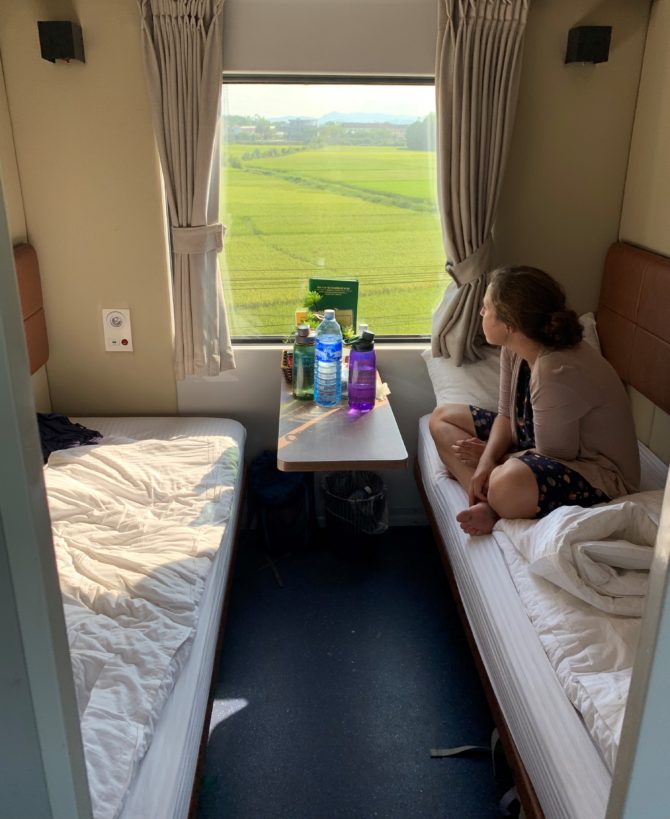
One last word of praise for Laos, in case there wasn’t enough in the last post: the butter chicken curry at the airport was swiftly made, cheap and delicious. The world has a lot to learn about airport dining from Luang Prabang. From there we spent a mere 38 minutes in the air until we touched down in Hanoi to begin our journeys in Vietnam. After five days we were both really, really impressed by this city and I totally understand why people sing its praises. I’ve never felt at a loss of things to see or do, even without any organised excursions.
This was definitely helped by staying in the Old Quarter, where the streets are inherently photogenic and almost everywhere is within easy walking distance. As we were warned, the roads are crammed full of motorbikes and crossing the road involves purposefully forgetting everything you ever learnt as a child. Traffic lights mean nothing and the only way to get across is to stride purposefully into the road. Looking left and right as you cross is actively dangerous, since you’re more likely to freeze and fail to move forward to where the drivers have already calculated you will be. At one point at a busy crossing a woman just took me by the arm and marched me across, clearly figuring that I wasn’t going to get there on my own. This slow-mo video of Randi doesn’t capture the vast numbers of bikes, but was the best way I could think to demonstrate the Matrix-esque ‘bullet time’ experience of becoming as zen as possible and letting the traffic flow around you.
Other than crossing the roads, however, the Old Quarter is very walkable and the area around the nearby lake, Hoàn Kiếm, becomes totally pedestrianised at the weekend, starting on Friday nights. Wandering around here was our favourite part of Hanoi as the city felt so vibrant and alive, with lots of seating areas by the lake itself. The legend of Hoàn Kiếm is that this was where the Emperor had to return his magic sword (which had successfully been wielded against China during a war) after a golden turtle appeared in the lake and asked for it back. Knowing this story in advance of going to a Water Puppet Theatre show was very helpful for understanding what on earth was going on.
No, there is no rapid transit system… yet. But the Hanoi Metro – the first of its kind in Vietnam – is supposed to start operating later this year! I will be quite happy to come back in a couple of years to check on its development.
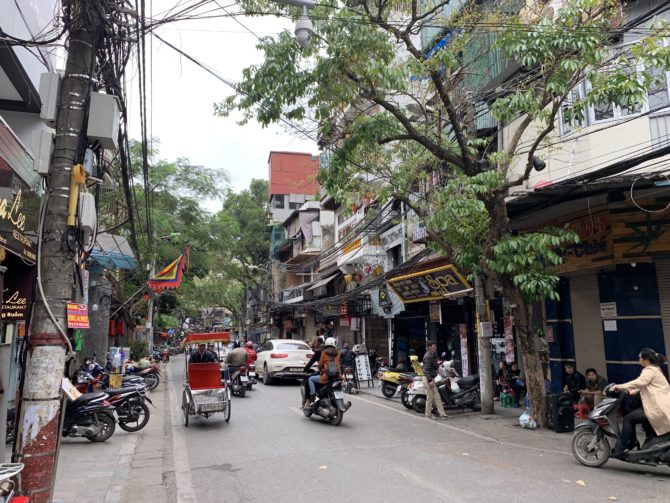
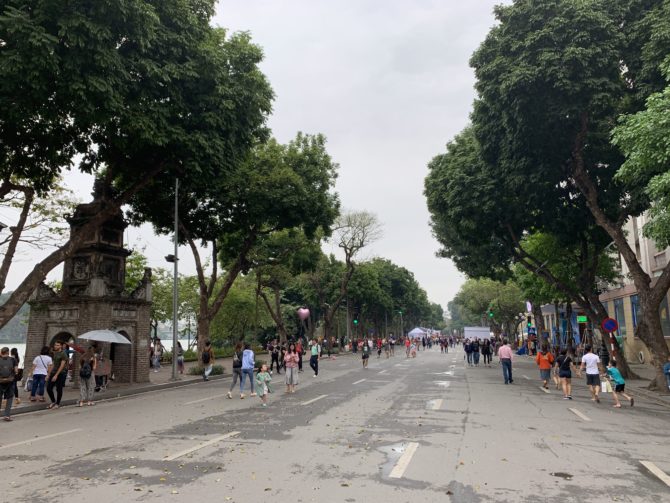
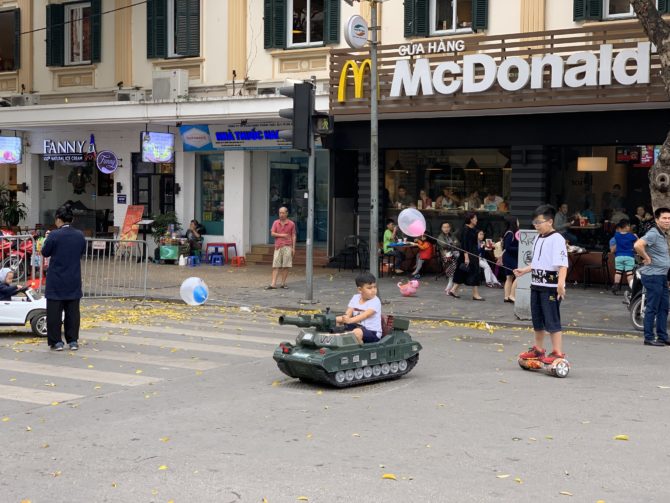
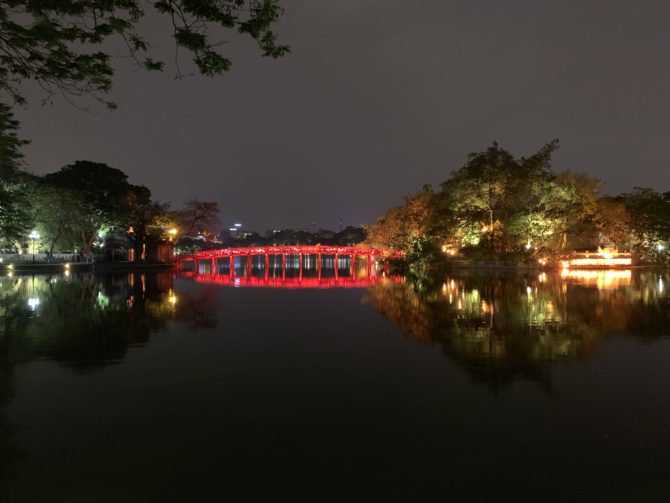
The story of the golden turtle was relayed to us during our student-run walking tour of the Old Quarter. This wasn’t exactly the typical walking tour experience: the main purpose seemed to be as an English-language learning exercise for the organisers, who were visibly excited to learn that Randi and I were both native speakers. Together with a German couple we took turns to chat with our guide as we wandered around the streets, not really stopping to talk much about our surroundings but getting a chance for a really interesting conversation about gender roles in Vietnam today. We also walked on some train tracks to take photos having been assured that no trains were scheduled at this time, which shows a surprising faith in railway timetables.
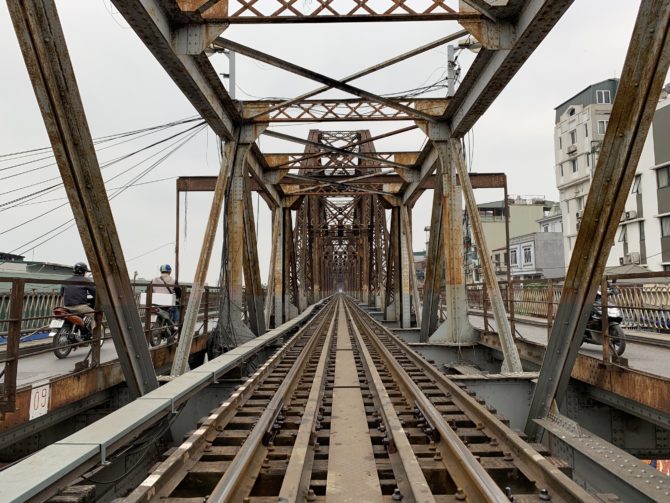
We also visited the Women’s Museum, with exhibits on female fighters in war and Vietnamese family life. My favourite game was to compare the different gifts which a bride’s family can expect depending on which ethnic group is marrying. It varies a lot. Some are in line for ‘hundreds of silver coins’, others for a machete and a pick axe, while other groups set the bar a little lower at chicken thighs. We also learnt that parents sometimes give a temporary ‘ugly’ name to their newborn child to make it undesirable to evil spirits. Examples of these ugly names were not given, but I’d like to think they are all Western ones.
I also enjoyed seeing the Temple of Literature – which was filled with graduating students when we visited – although we didn’t spend very long there. Unlike some places (*cough* Bangkok’s Grand Palace *cough*) all of the entry fees in Hanoi have been very reasonable so there’s no pressure to stay for a long time, and the weather has been mercifully cooler than the rest of our Asian explorations so we could even give the suncream and mosquito spray a break. On our last couple of days the city did descend into a polluted mist which was especially evident on the morning we decided to visit the Ho Chi Minh Mausoleum. Uncle Ho, as he is known here, was keen on a simple cremation but found that it’s very easy to be ignored after you’re dead and now visitors queue up (mornings only) to shuffle past his embalmed body. There are guards present who would presumably stop anyone who tried to break the rules by taking a photo – and to be honest, I wish there were more tourist spots where photography was so strictly prohibited that you can all look without dodging other people’s camera shots.
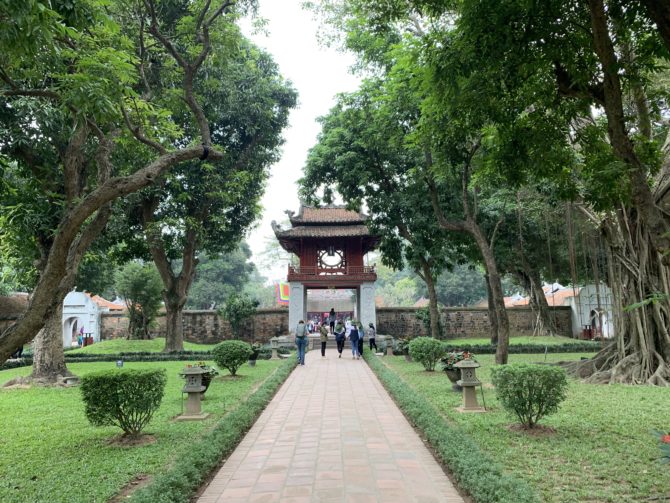
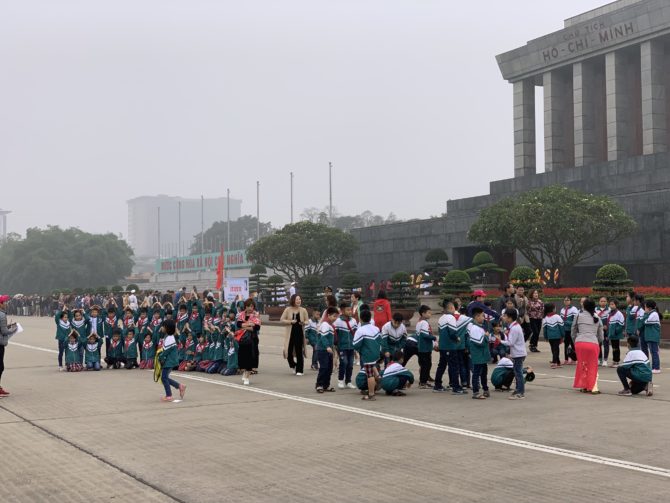
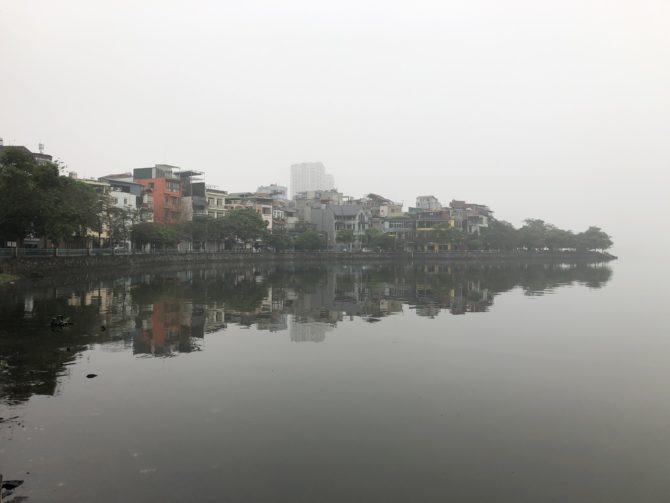
There’s an odd quality to the Mausoleum and a couple of the government buildings nearby, decked out in the requisite hammers and sickles and built in a grey Marxist-Leninist style to match the sky. In Russia, the collapse of the USSR provides a sudden historical break point. You can still find the statues of Lenin there, but they belong to a past era to inspire curiosity or nostalgia or indifference or revulsion or whatever. In Vietnam, it still feels obviously anachronistic to see a statue of Lenin in the post-1990s reform era and yet there he is (away from the Old Quarter, towards the more Sovietesque park with the rundown-looking bumper cars) and so too is the same one-party state. Indeed, as a reminder of what lies in the background, the BBC seemed to be blocked on at least one internet connection we used although not on others.
Similar ambiguities are on display at what remains of the Hỏa Lò Prison. The majority of the exhibition is about the use of the prison by the French colonial forces to detain, torture and execute Vietnamese prisoners, although the references to exactly who was doing the detaining are noticeably watered down in the French translations. It then moves on to the use of the prison to hold American prisoners of war during the Vietnam War, most notably John McCain, in what was dubbed the ‘Hanoi Hilton’. We learn that for American pilots this was a “serene period of their lives” with plenty of fun group activities and holiday celebrations. Except we all know that this is obviously untrue, and prisoners were tortured here. The tourists know it, and the Vietnamese authorities know that we know it, and it takes a certain mindset to keep insisting on something which is obviously false rather than opt for a subtler approach.
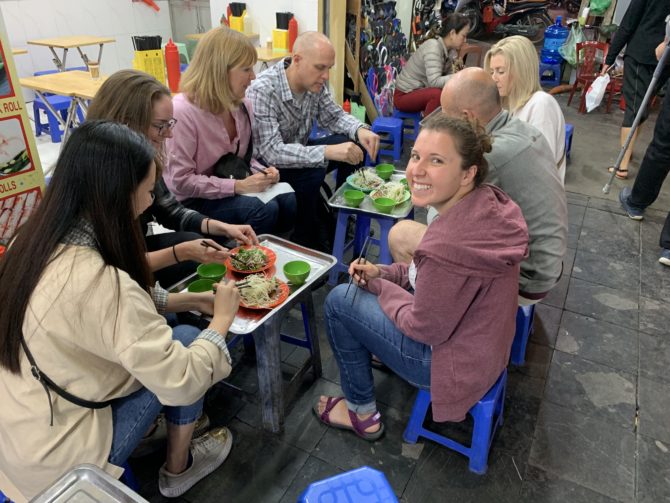
Much more fun than the prison – and one of the very best things we did in Hanoi – was our street food walking tour on Monday evening. In a small group of Brits (and Australians… originally from Britain) we were guided through eight different restaurants to sample everything from bánh mì to glass noodles to the delicious egg coffee which is a speciality of Hanoi. One restaurant was notable for displaying a large topless photo in the corner of its owner when he was in his 20s. We saw him outside (roughly two decades on) and he feigned embarrassment very unconvincingly. Overall, the food tour did not skimp on the portion sizes and by the coconut ice cream finale I was stuffed.
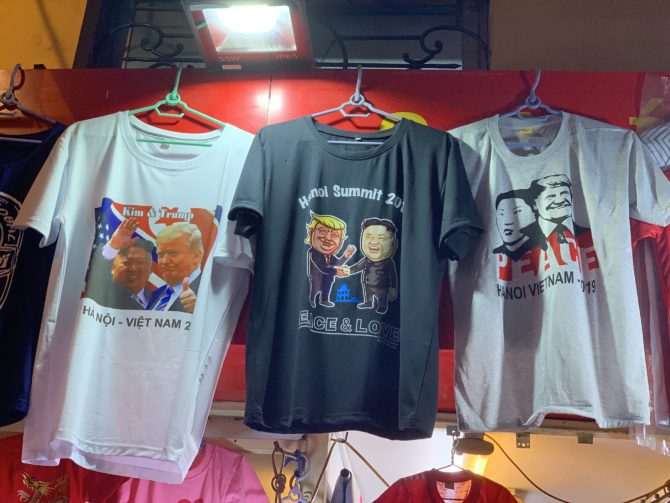
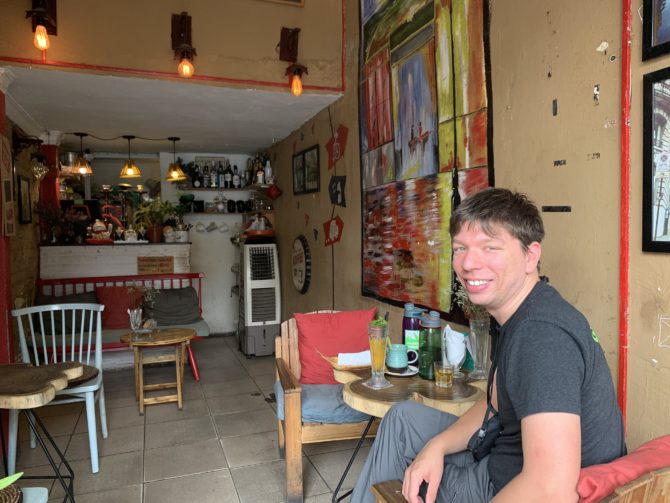
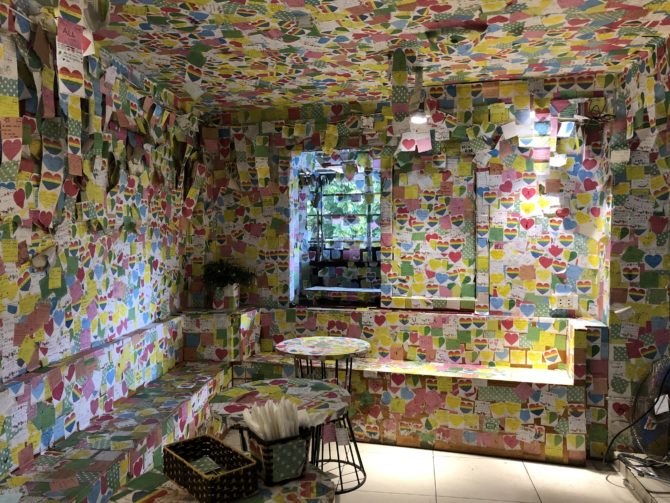
On our last day we headed back to The Note Coffee to blog, a café which (as you can see) is festooned with post-it notes. Here we ran into one of Randi’s old school friends who just happened to be in Hanoi, and our blogging was paused for a great conversation about the world. Then, after dinner, we headed for the railway station for our next overnight train to Hue. Unfortunately Randi was in the midst of a sinus infection by this point so it wasn’t a perfect journey, but the train was perfectly comfortable and ran on time. The only issue for me was that the ride was pretty bumpy, which left me with a headache when I foolishly tried to read before bed.
I’m struggling to finish this post because it was written in so many fits and starts that I’m worried I’ve lost the thread of Hanoi and failed to do justice to the city. The streets just have so much character and the city feels like a confident, busy place which is not overwhelmed by tourism but treats its visitors well. Just make sure that you plan any visit here to include a weekend to take full advantage of the lake!
Bonus English Language Time
Here is an English lesson on Vietnamese TV:
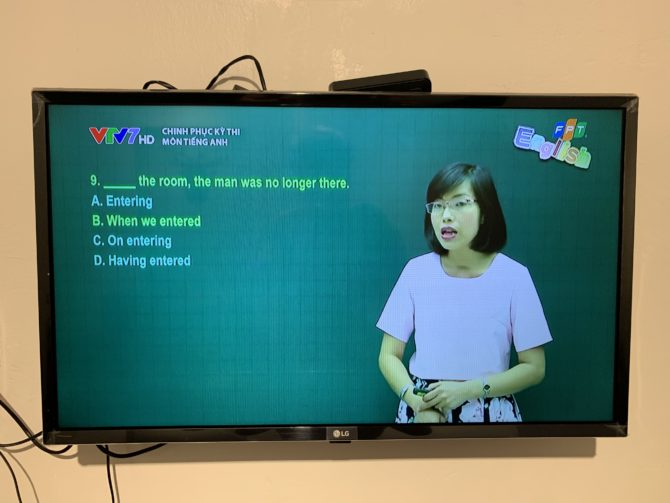
I dispute that this is the only acceptable option. For example:
“We saw the ghostly figure from the window but continued to walk on. On entering the room, the man was no longer there.”
Of all the countries we’ve visited, Laos is the one I had the fewest preconceptions about. I wasn’t even sure how to pronounce it, although after some googling I’m sticking with Laos (rhyming with blouse) rather than Lao (which some travellers use) although it is the Lao people, the Lao language and so on. I very vaguely recalled that it was bombed by the US during the Vietnam War, although my memory was not commensurate with the extent of the bombardment it suffered. I knew there were no trains for us to travel on – although construction of a Chinese railway is underway and we saw the evidence of this from our boat – and that it was the only country on our travels (apart from Singapore, weirdly) where my global data roaming would not work. So all in all, Laos seemed like a rather mysterious bridge we were passing through between Thailand and Vietnam so as not to break our circle around Southeast Asia.
Perhaps unsurprisingly, with little expectations, we have really enjoyed our time here. It’s an annoying cliché for tourists to announce that they have found “less touristy” places, and the places we have visited are not actually “less touristy” than Thailand in terms of how local people make a living. Indeed, according to our AirBnb host in Luang Prabang, the entire economy of this city is based on tourism so it’s worrying that visitor numbers have dropped off in the last few years, most likely due to the Chinese economic slowdown. But Laos is considerably less busy than Thailand. The pace is calmer and more relaxed. There’s even a nationwide curfew at midnight to protect the early-morning giving of alms to monks, and as the sun goes down the relative lack of street lighting contributes to this peaceful mood. Wandering through the night market of Luang Prabang is worlds away from Bangkok or Chiang Mai. At one point in our planning we considered skipping Laos – I’m so glad we didn’t.
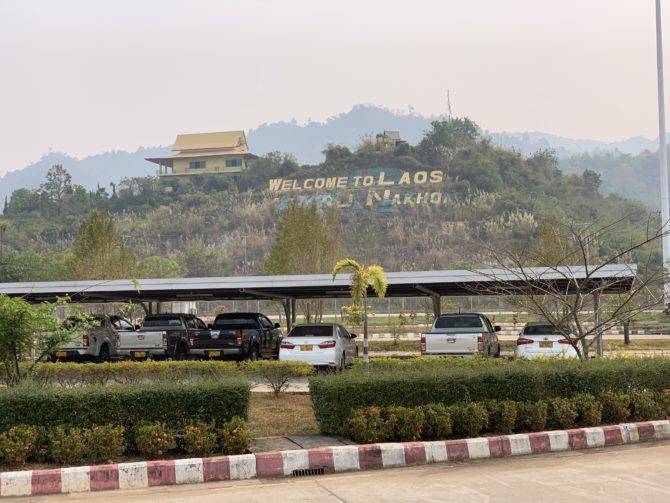
Our little minivan of travellers was playing techno music at a subdued volume as we drove to the Thai border at 8 in the morning, got our exit stamps and then crossed from left-hand-side to right-hand-side driving as we made it over the Thai–Lao Friendship Bridge. The process for purchasing your visa on arrival is somewhat strange. After filling out multiple forms with the same information (which, as usual, are never used and never seen again) they take your passport to stick in a full-page visa and then pass it to someone else for them to try and recognise your face and match it up with the right passport photo. Understandably they do not always get this right, so there is a lot of “nope, that’s someone else” until you get your passport back and are free to enter the country.
From here we took a slow boat along the Mekong River for two days to Luang Prabang, stopping for the night at the small town of Pak Beng. On the first day our group was a little late to the boat and the only seats left were the sideways benches at the front, which were not hugely comfortable. Randi and I spent a lot of the journey sitting on the floor instead, but the atmosphere was nice and we worked hard to convince two young children to keep poking our noses for our mutual entertainment.
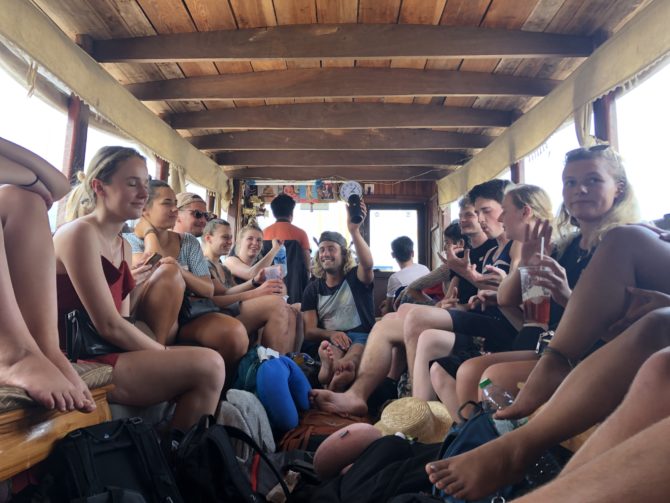
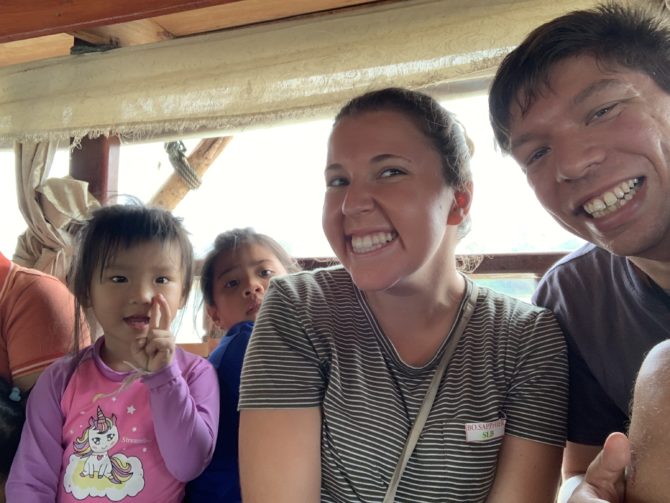
Pak Beng may be small but we found a wonderful restaurant for dinner after eschewing the bar and wandering along its main (and only?) road, lit by two small bonfires and minimal electricity. The bread for sale, on the other hand, is truly the worst bread. It tasted like it came from a children’s plastic play set. All of the other food we’ve had in Laos has been exceptionally good – and the fish which Randi ordered last night might be the best fish I’ve ever tasted – so if you’re visiting, please just eat anything other than a baguette.
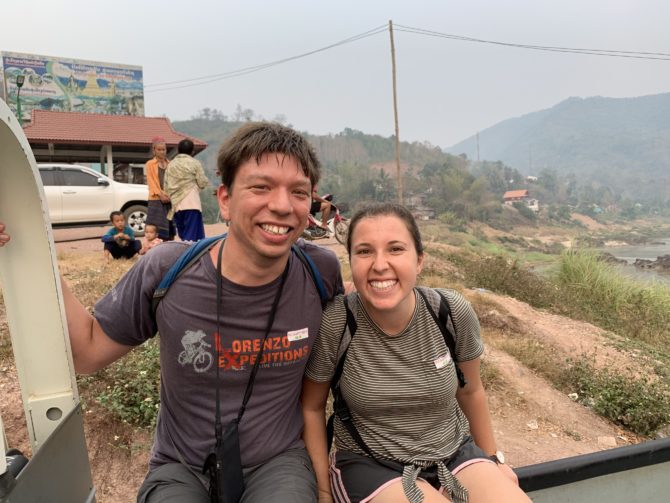
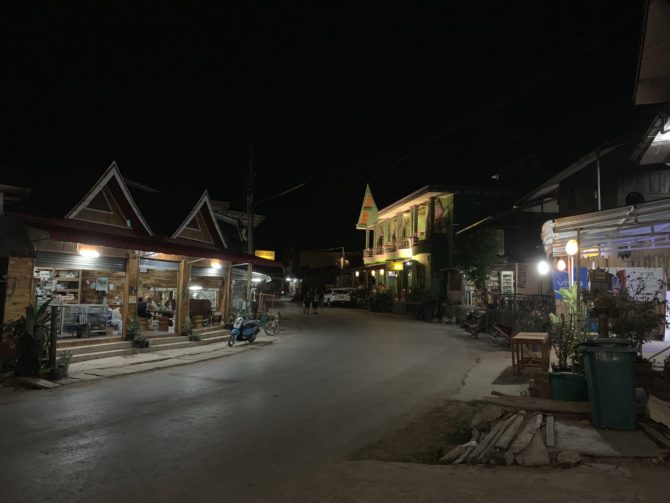
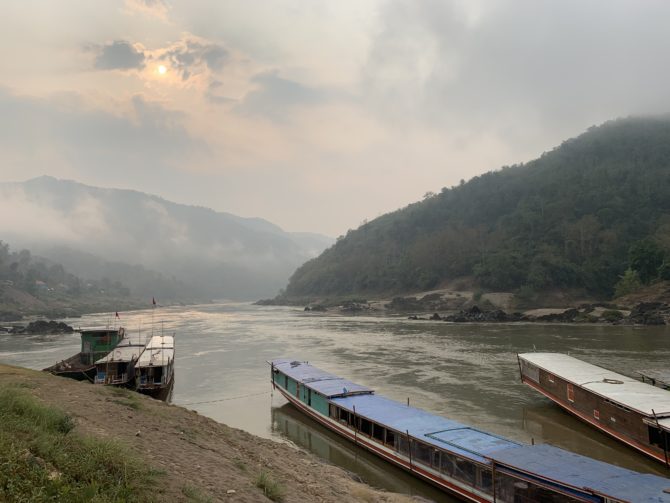
We arrived into Luang Prabang the following afternoon after a less crowded boat ride. Remarkably, I could even read my Kindle on it without getting a headache, which is very rare for me and boats. Luang Prabang is surprisingly small. You’re spared a paragraph in this post about the public transport around town because there’s no need: everything was easily walkable from our AirBnb by the river. In the centre is a small hill, Phou Si, which is common to walk up (there are stairs) to watch the sunset from the temple at the summit. It’s the one time in Laos where it did feel a little crowded, but the sun was full of colour in a way which is never quite captured on photos. (This is true even in those photos where people pose ‘holding’ the sun, which I have now seen done sixty thousand times during our travels.)
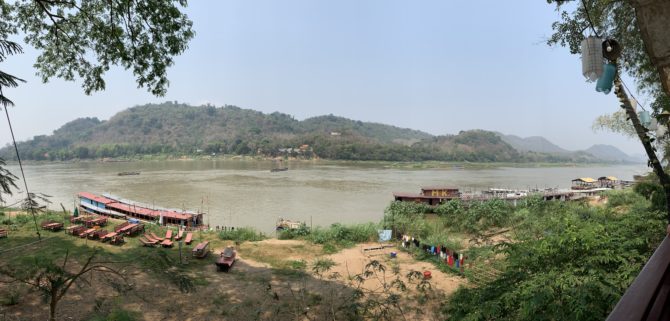
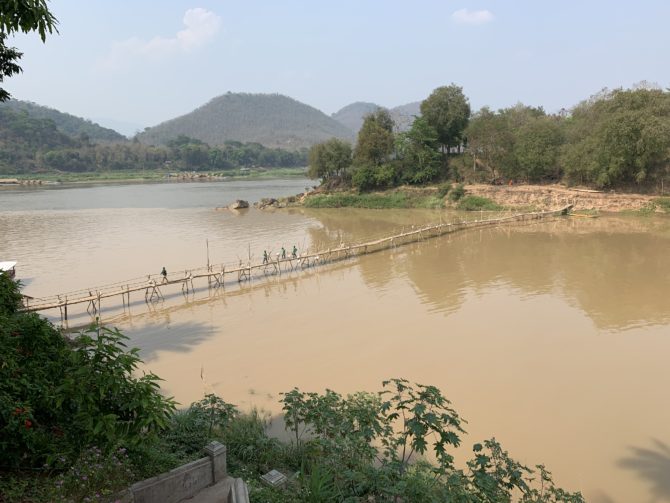
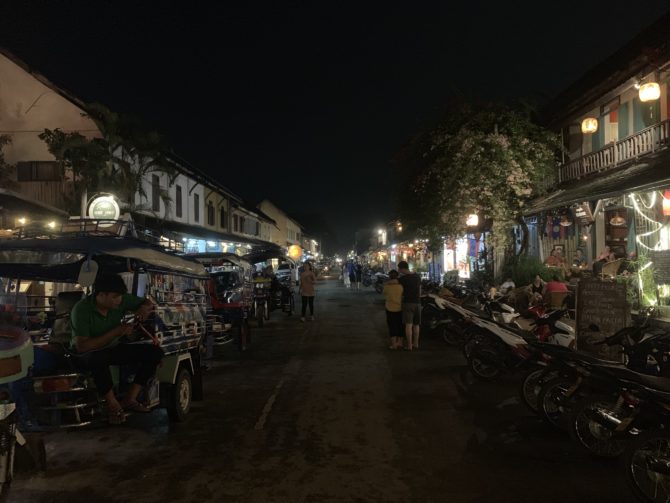
Yesterday we ventured out of town early to get to the Kuang Si Falls before the crowds. We began with the trek to the top of the waterfall where we discovered that the disadvantage of getting there early is that you get to be the ones to break a lot of spider’s webs. On the other hand, the whole place is beautiful and peaceful enough to sit and read by the main waterfall before getting changed and going for a quick dip around some of the lower falls. We did not go to investigate the “secret falls” described on some travel blogs, which always include a quick confession that they had to get past a locked gate and fencing to get there. I’m not sure everyone understands the difference between “secret” and “closed”.
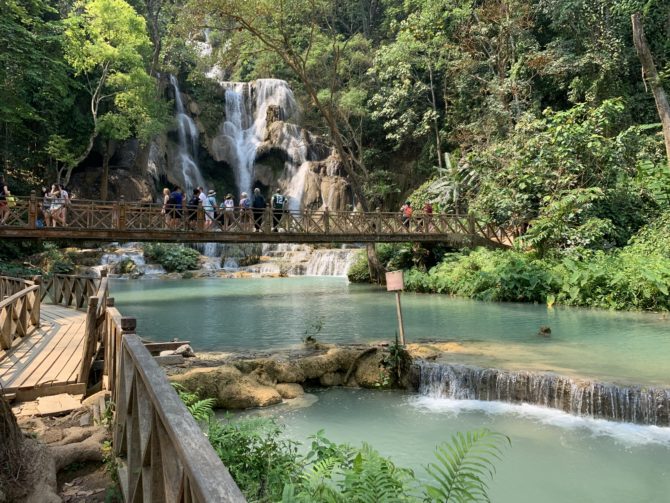
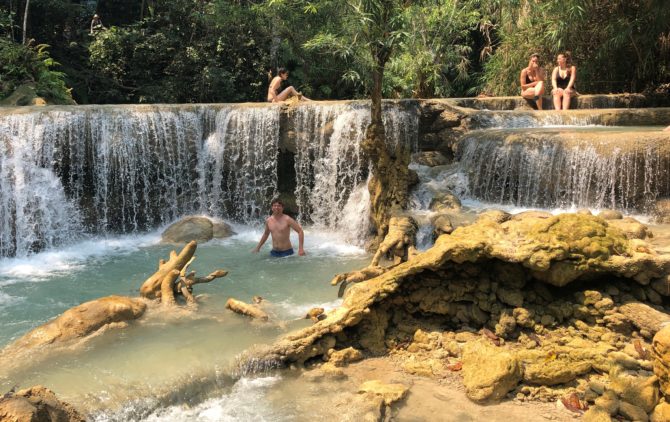
Tonight we’re leaving Laos and flying to Hanoi. I feel a little bad about this. I had wanted to get across Southeast Asia with no short-hop flights, but (as mentioned) there are no trains and we chickened out of our original plans to take the 24-hour bus. (This trip is mostly described online as the ‘Journey from Hell’ although one British blog summed it up as ‘Not So Bad’ which British people will recognise as meaning roughly the same thing.) But I can totally see why some people – including our AirBnb host – visit Laos and then end up staying for years. If you are in the region, don’t miss it out!
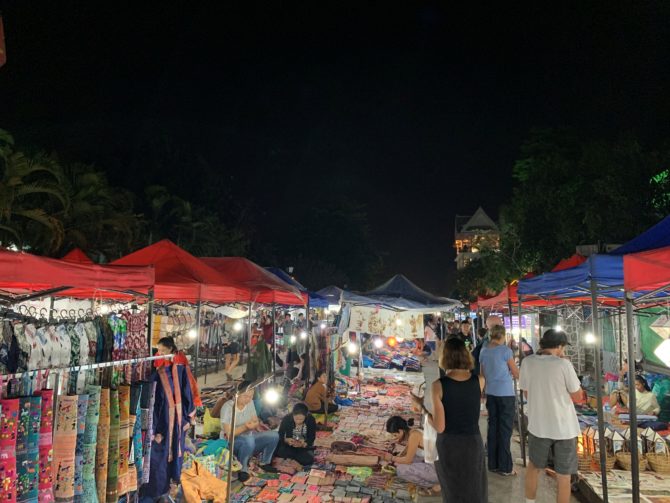
Fair warning: this post is going to be overloaded with elephant photos. If you really hate elephants, skip this one.
We only had two days to spare in Chiang Mai, so soon after arriving at our hostel we moved quickly to book the tours we wanted while we were here. This left us with a couple of hours to conduct an improvised whistle-stop tour of the old town by ourselves, which is quite walkable and surrounded by remnants of old city walls, but – like the rest of Chiang Mai – suffers from a perpetual haze of pollution at this time of year (caused by agricultural land burning) which greys out the sky. Thankfully neither of us started coughing up blood but we were happier to skimp on the city than we might otherwise have been. Well, that and there’s a limit to the number of temples which can hold your interest.
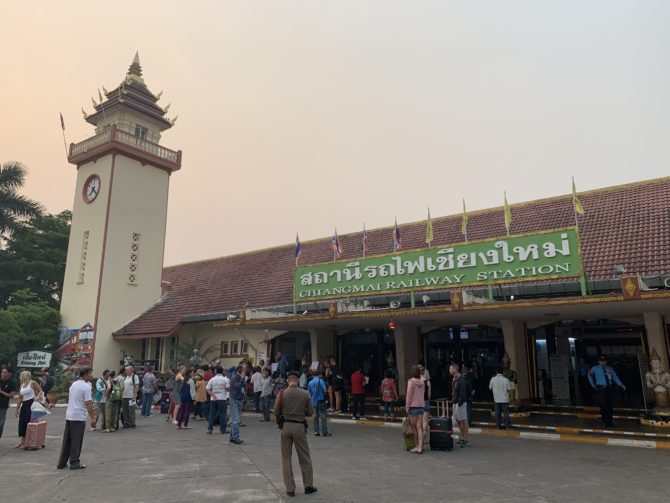
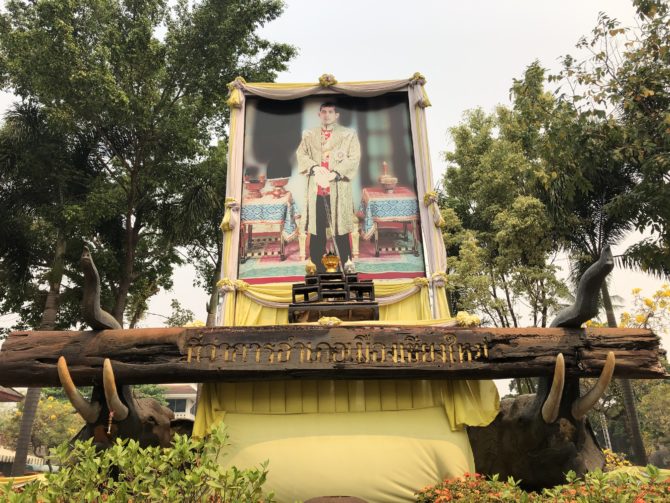
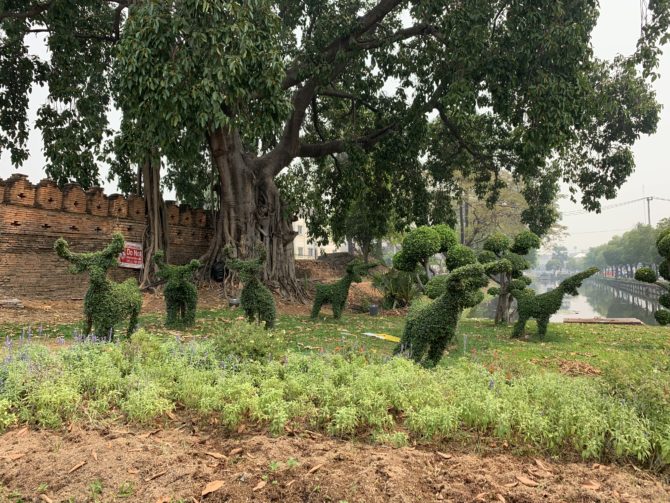
Less time for the city meant more time for elephants! We went on a half-day visit to Toto’s Elephant Sanctuary and when I compare it to the last time I saw elephants, in Sri Lanka, the difference is profound. Our tour group consisted of one minivan’s worth of people (side note: I was childishly proud of drawing little flags in the ‘Nationality’ column of the visitor form we had to fill in, because the next person from China felt compelled to continue the pattern) and the atmosphere at the sanctuary was incredibly relaxed and chilled. We did not ‘take the elephants for a walk’, we followed the elephants as they wandered into the jungle at their own pace. Unlike Sri Lanka there were no chains or hooks in use, just a handful of cheerful elephants including one bounding eight-month old who kept charging about and occasionally slipping over.
The photos speak for themselves, but it was wonderful to spend time with these improbable creatures. At one point Randi was concerned that we might be feeding them too many bananas and asked if it was possible to overfeed them, but was reassured that they consume 300kg a day and are basically always eating.
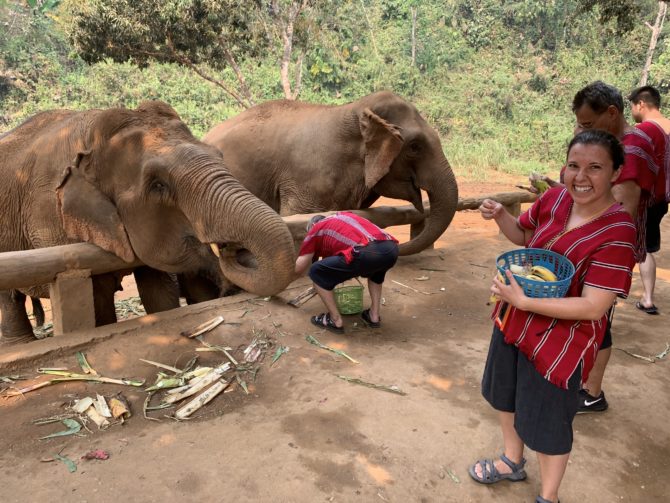
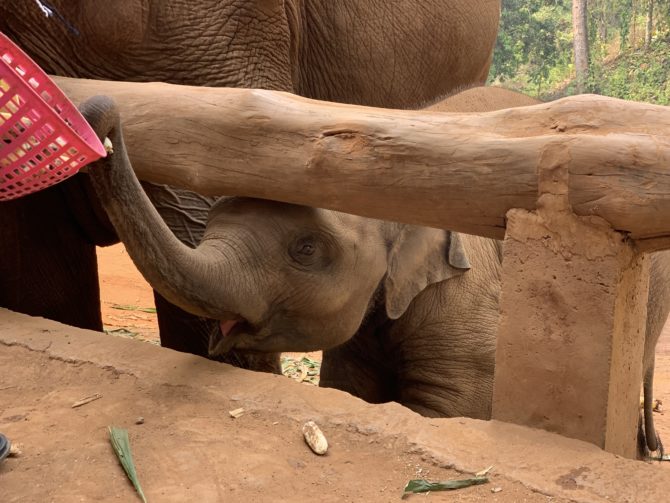
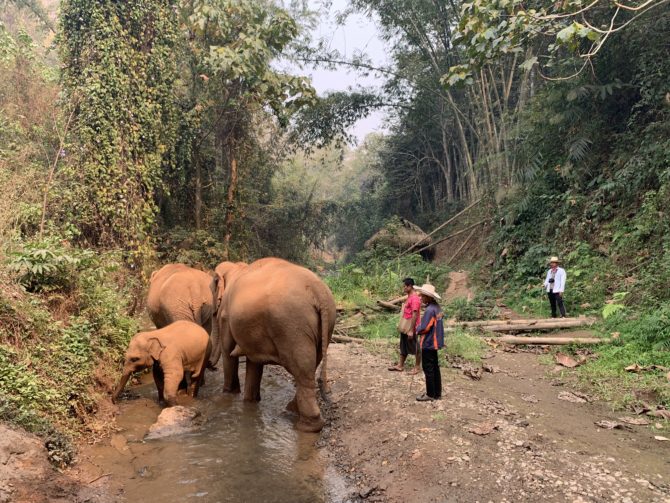
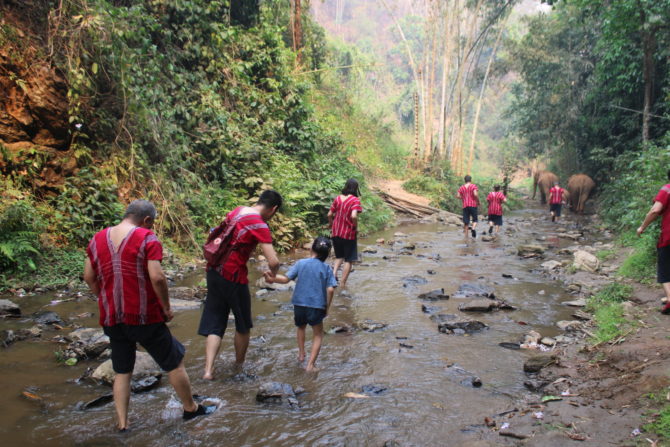
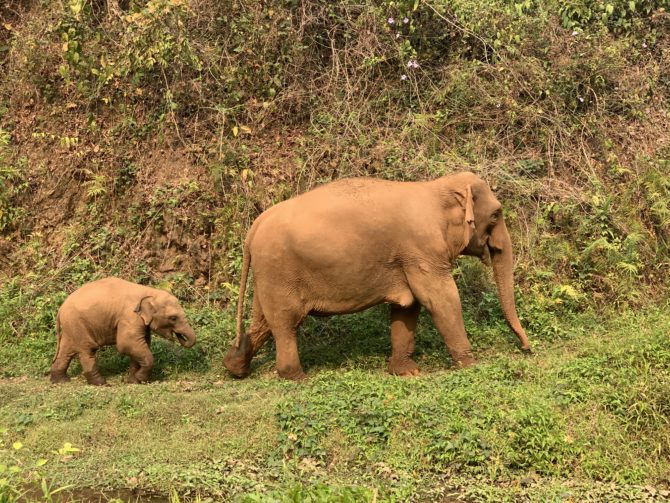
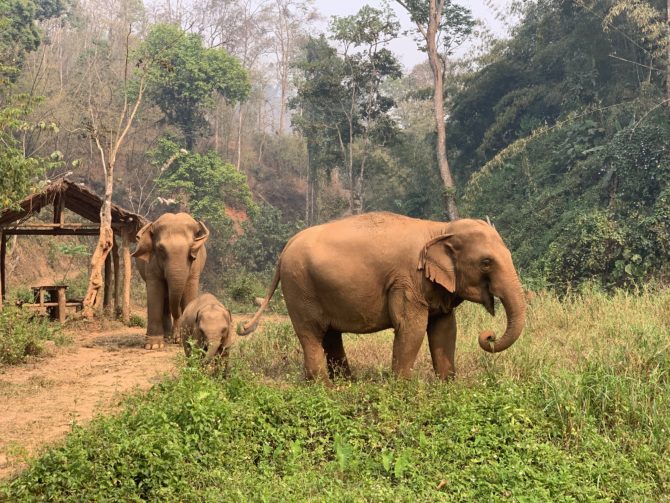
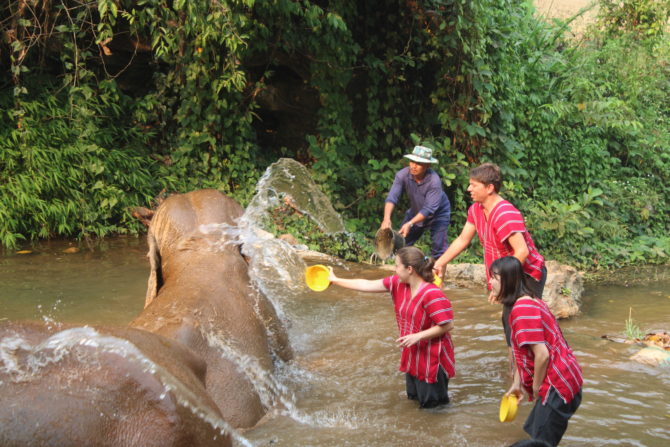
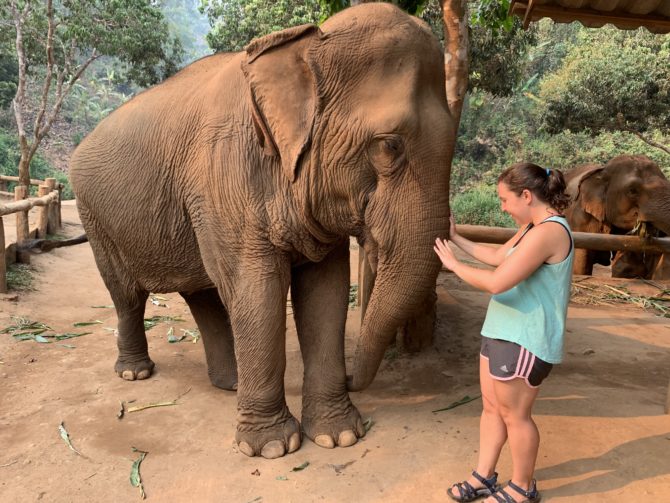
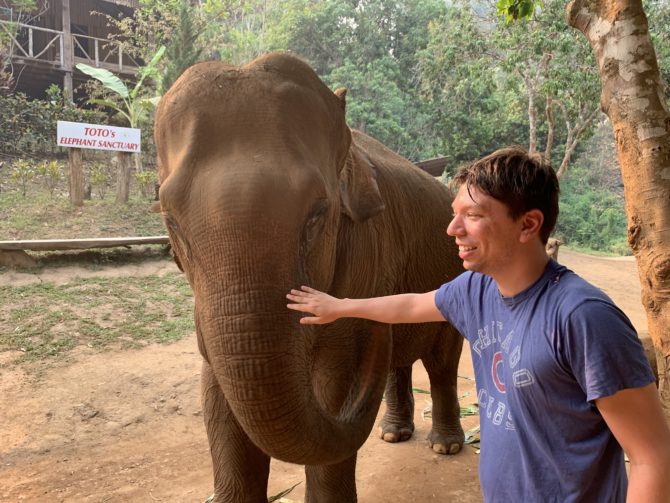
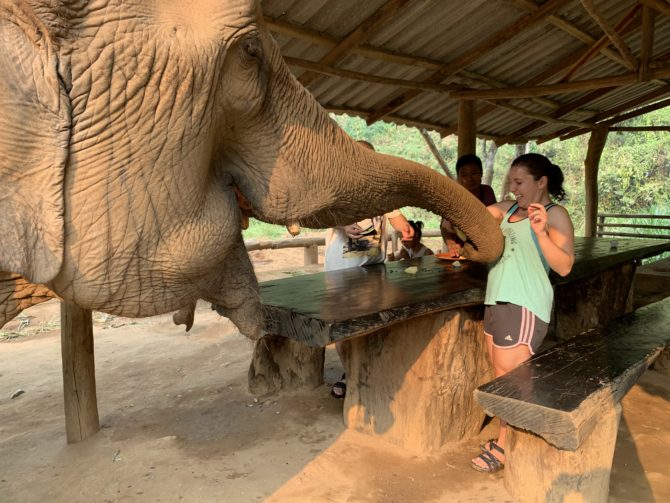
Our tour the next day was a jungle trek just outside the Doi Inthanon National Park. Aside from the very windy drive to the starting point this was a really, really lovely tour thanks to our amazing guide, who took the two of us from his village through the most jungley environment I’ve ever been in. The ‘path’ was tentative at best, covered in slippery leaves which our guide kept brushing out of our way, and he led us along armed with a large knife put to a great many uses including cutting back plants growing over the route, fashioning us impromptu walking sticks and slicing through the branch of one particular tree to show how we could drink the water inside.
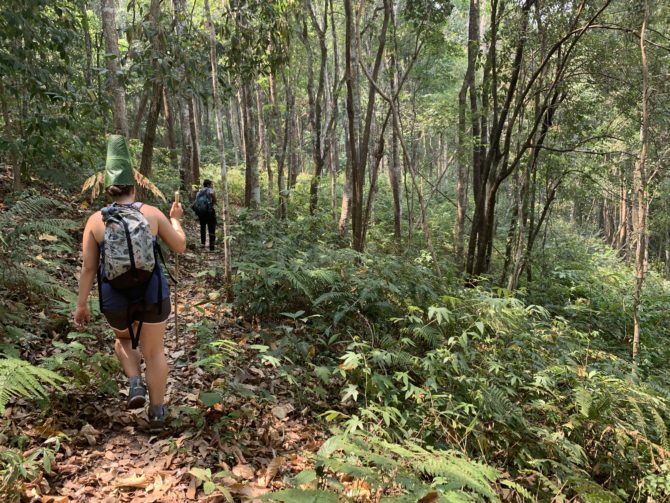
We also really enjoyed our conversations together. His English was halting (entirely self-taught over the last couple of years of doing tours) but we learnt of his desire to visit Europe one day if he ever saved up enough money to take his first plane. There was also a tragic moment where he asked Randi if Barack Obama was still President, and even though it’s now 2019 she had to break the news to one more person in the world about Trump. (He had never heard of him, which was rather refreshing.)
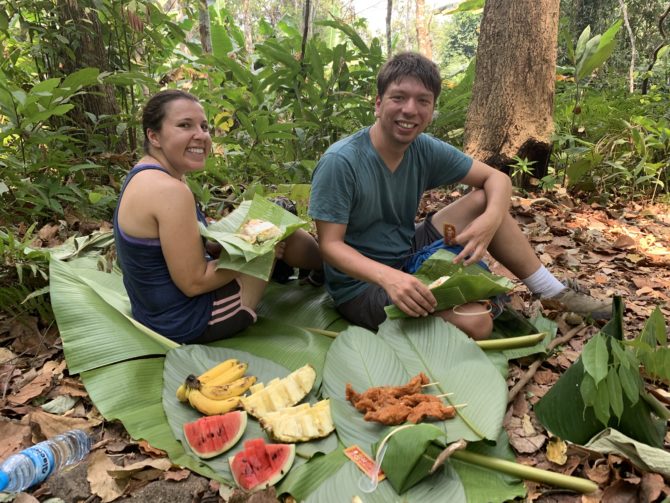
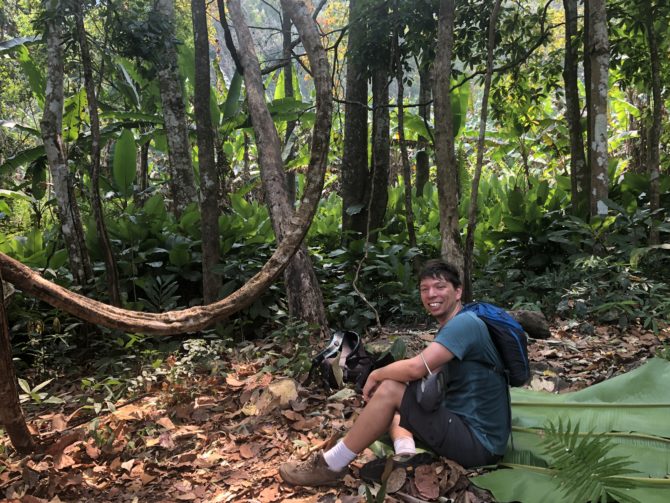
The tour ended at another elephant sanctuary and freezing cold waterfall which I begrudgingly took a quick shower in, and have to admit was somewhat refreshing. Back at the hostel, we took advantage of the free hour-long massages which the hostel offer in return for booking tours through them. Having worked at Groupon for many years I was well aware that there are both ‘nice soothing massages’ and ‘fearsome stretchy massages’ in the world but have never actually paid for one before and certainly didn’t remember which was which. Well, it turns out that the ‘Thai massage’ is the scary one… although I did enjoy the experience. I imagine it’s like being tortured by a professional torturer (wait, this isn’t going to be as bad as it sounds) only working to a much lower threshold of pain. Controlled and purposeful, in other words, and not just being beaten up by a masseuse.
Other than a brief visit to the extremely crowded Saturday night market along Wualai Walking Street (and our quick escape to an Indian restaurant) that pretty much sums it up for Chiang Mai. The next day we spent most of the day being driven to the Thai border town of Chiang Khong ready for our slow boat into Laos tomorrow, but we did stop briefly at the White Temple (Wat Rong Khun) in the province of Chiang Rai. We didn’t actually go in, but even from the outside this still ranks pretty high in the temple index, probably because it turns out to have been repurposed as an art exhibit.

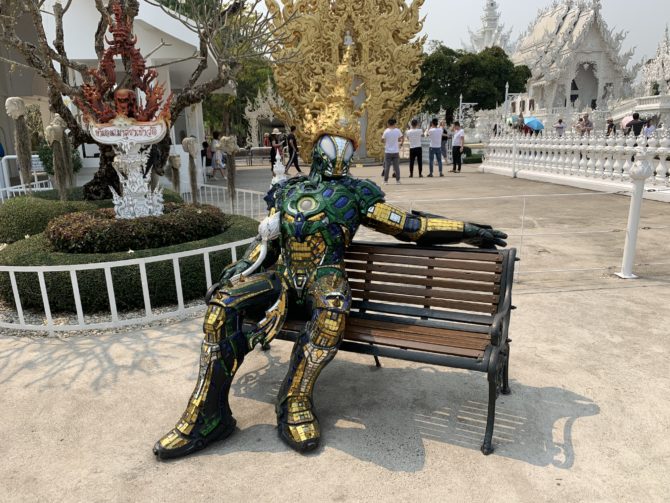
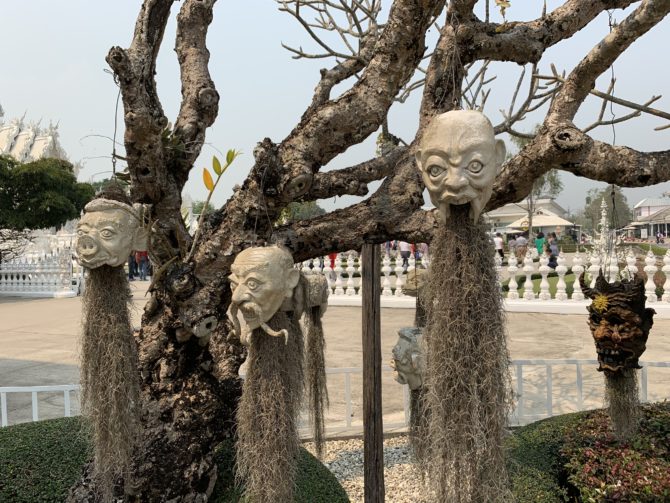
We’ve seen a real variety of places within Thailand, but after Koh Lipe I think this was the stop I most enjoyed thanks to the elephants and the jungle. I am really not sure what to expect of Laos, but armed with the US dollars required for the entry visa I am ready for the next stage of our journey.
